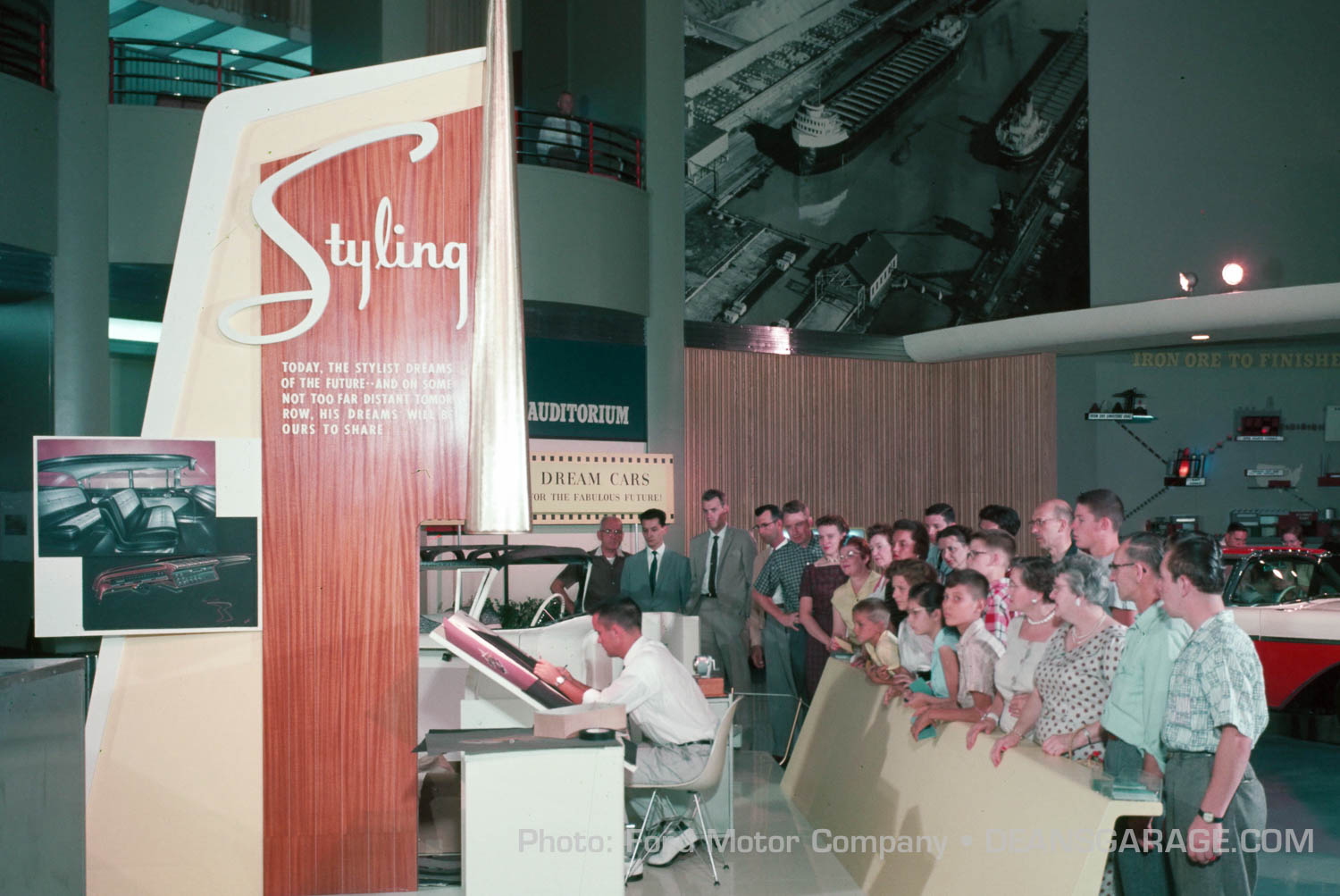
The Ford Rotunda
By Todd Duhnke
The design, styling, and engineering of the automobile is the focus of many stories in Dean’s Garage. In this post we will look at one of the methods Ford Motor Company used to educate the public on the importance of these topics.
In 1933 Henry Ford decided to build an exhibit for the 1934 Chicago World’s Fair. Situated on eleven acres south of downtown and next to Lake Michigan, it was the largest building at the exposition. It was Henry Ford’s salute to “American Progress, Agriculture and Industry.”
The building was designed by Albert Kahn, who designed many of the most famous buildings in Detroit such as the Packard factory and General Motors Building.
Photos courtesy of Ford Motor Company.
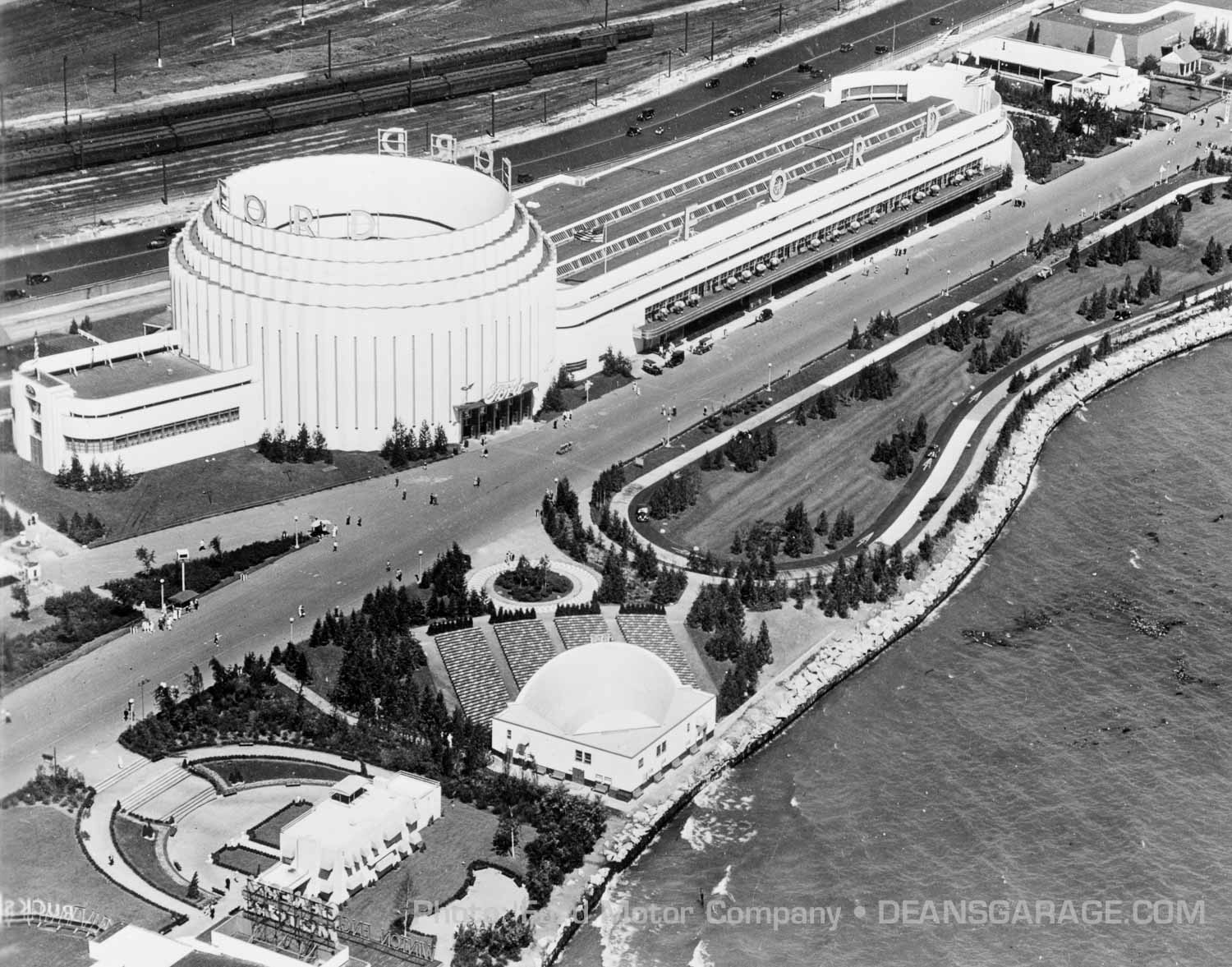
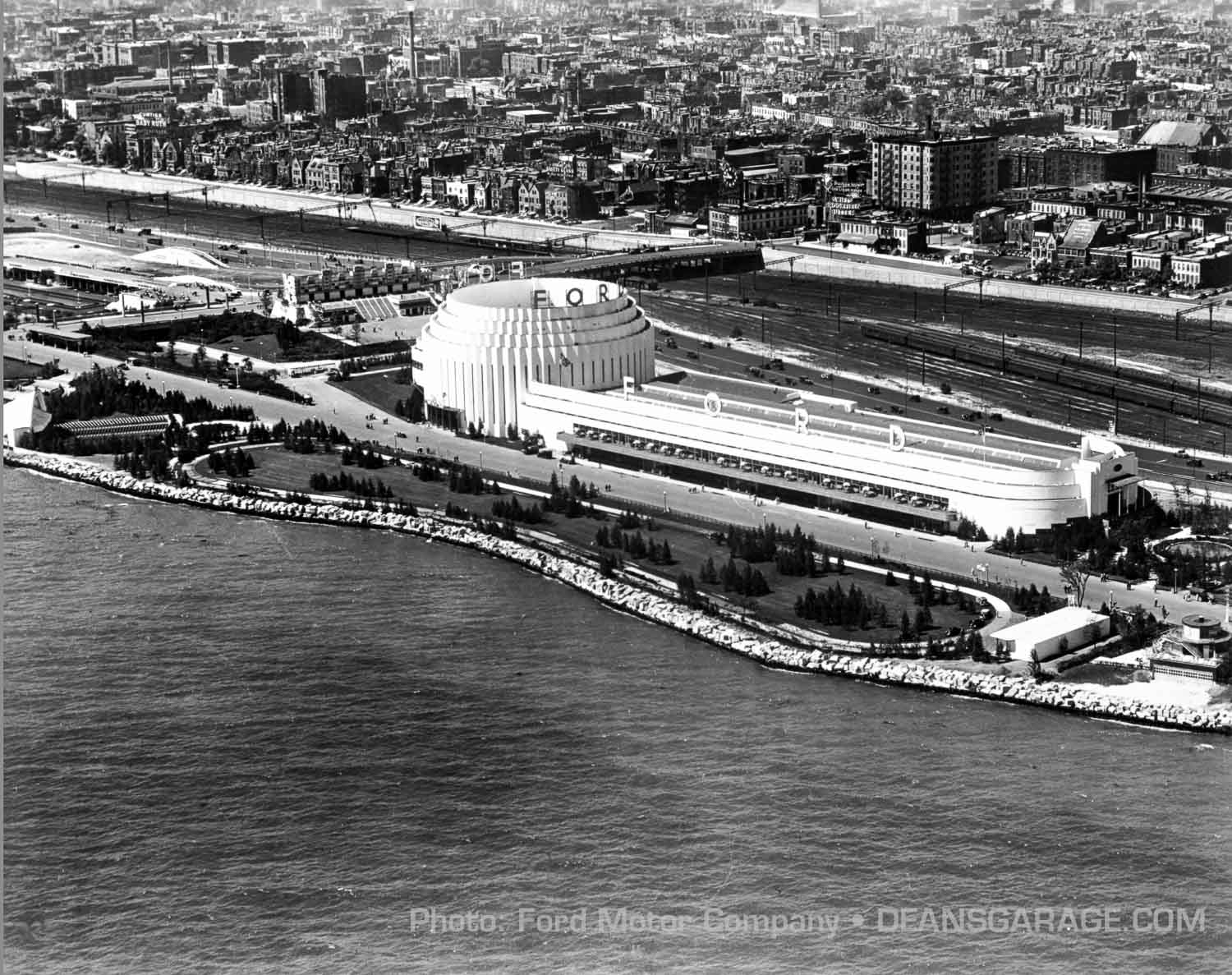
At 900 feet long by 213 feet wide and 12 stories tall, it dwarfed other exhibits. The most interesting design element was the Rotunda. The gear shaped center section was lit by 9,000 flood lights. One would naturally think it would take years to build something of this magnitude, but Henry Ford completed it in a little over three months.
The outside featured a test track, park and “Symphony Gardens” amphitheater. Inside there were exhibits showing an 1850’s workshop, soybean production, the progression of transportation and various displays of manufacturing operations. The inside of the Rotunda was open above and featured a large 90-foot, lighted, electrically-driven rotating globe highlighting Ford’s activities around the world. Large murals adorned the walls above the exhibits showing much of Ford’s history to date.
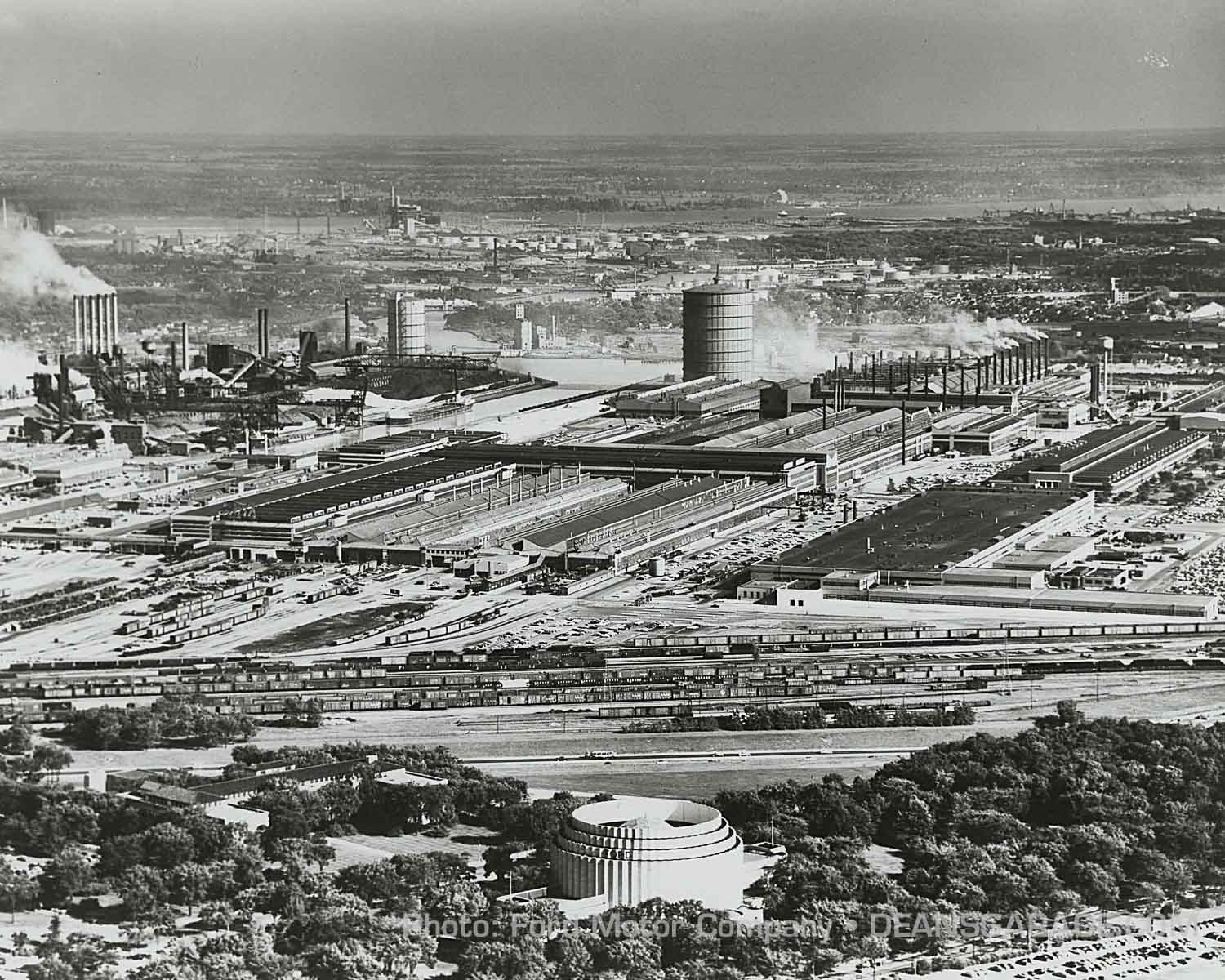
In late 1934, after the World’s Fair closed, Henry Ford decided to move the Exposition Building to Dearborn. He wished it to serve as a visitor center and a place from which tours of the Rouge complex could be started. Albert Kahn was dispatched to Chicago to see if the building could be moved. Kahn stated that it indeed could, with the exception of the long wing. He redesigned the Rotunda and specified that it be made of much more permanent materials.
Initially Henry Ford thought of positioning the building within Greenfield Village. Edsel Ford convinced Henry to place it on a 13-acre field directly across from the Ford Administration Building on Schaefer Road. Just north of the River Rouge complex and Detroit Industrial Expressway (Now I-94).
While the original Rotunda exterior was made primarily of plasterboard, the rebuilt one would be constructed of steel and Indiana Limestone. The original murals were reinstalled and a new south wing constructed which contained a 388 seat theater. The work to reconstruct the Rotunda started in the spring of 1935 and was completed in early 1936. It was open to the public on May 14, 1936, with over 22,000 people in attendance.
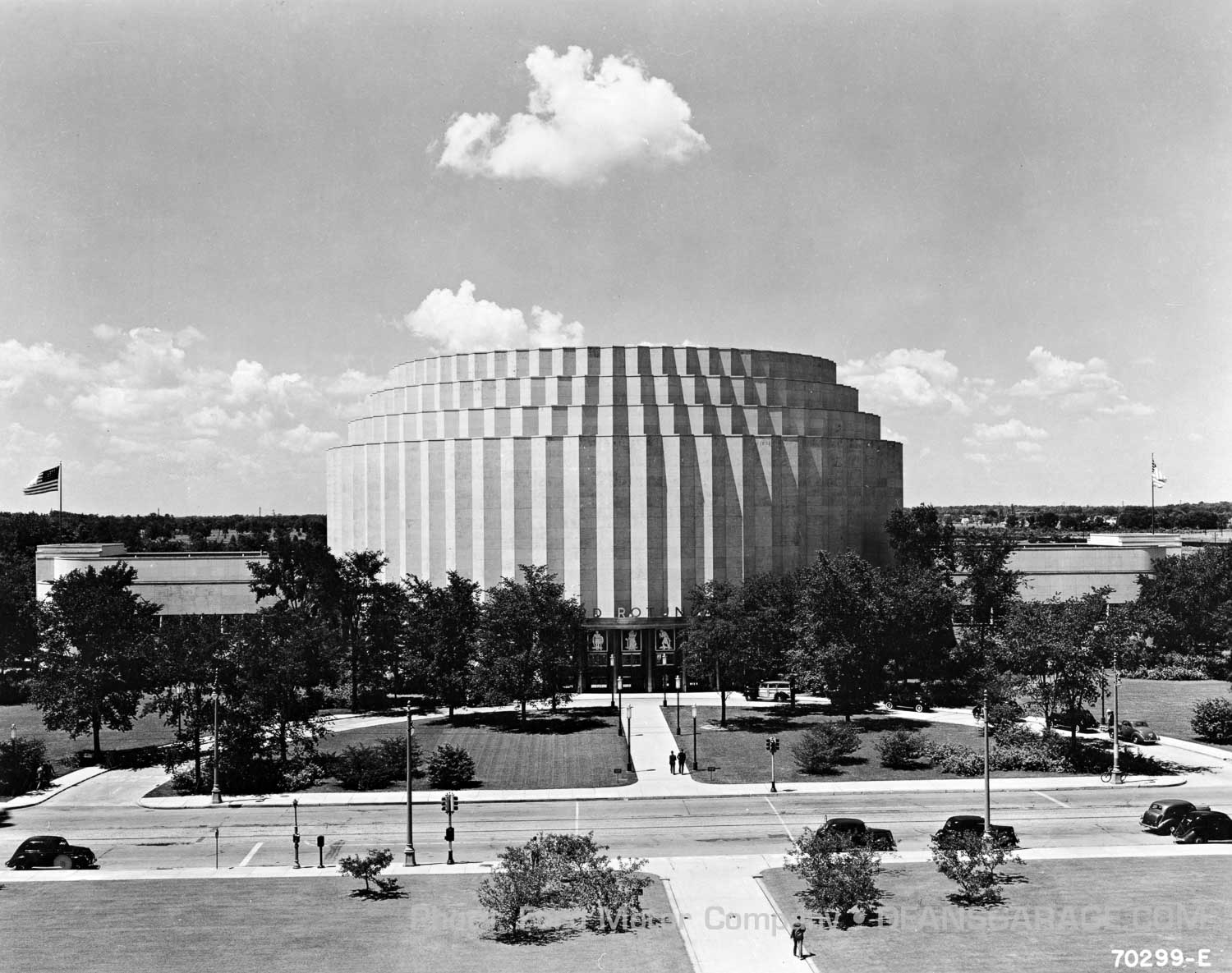
This photo was taken from the Ford Administration Building looking across Schaefer Road at the front of the Rotunda. Rare for its time the Rotunda was air conditioned and received steam heat via an underground passageway from the Administration Building. On the side and backside was “The Roads of the World” test track that duplicated the road surfaces of some 17 countries. Demonstration rides in new Fords were provided to visitors on this track. The Rotunda had become one of the greatest attractions of the Detroit area. Over 1,000,000 people per year visited the Rotunda before the war.
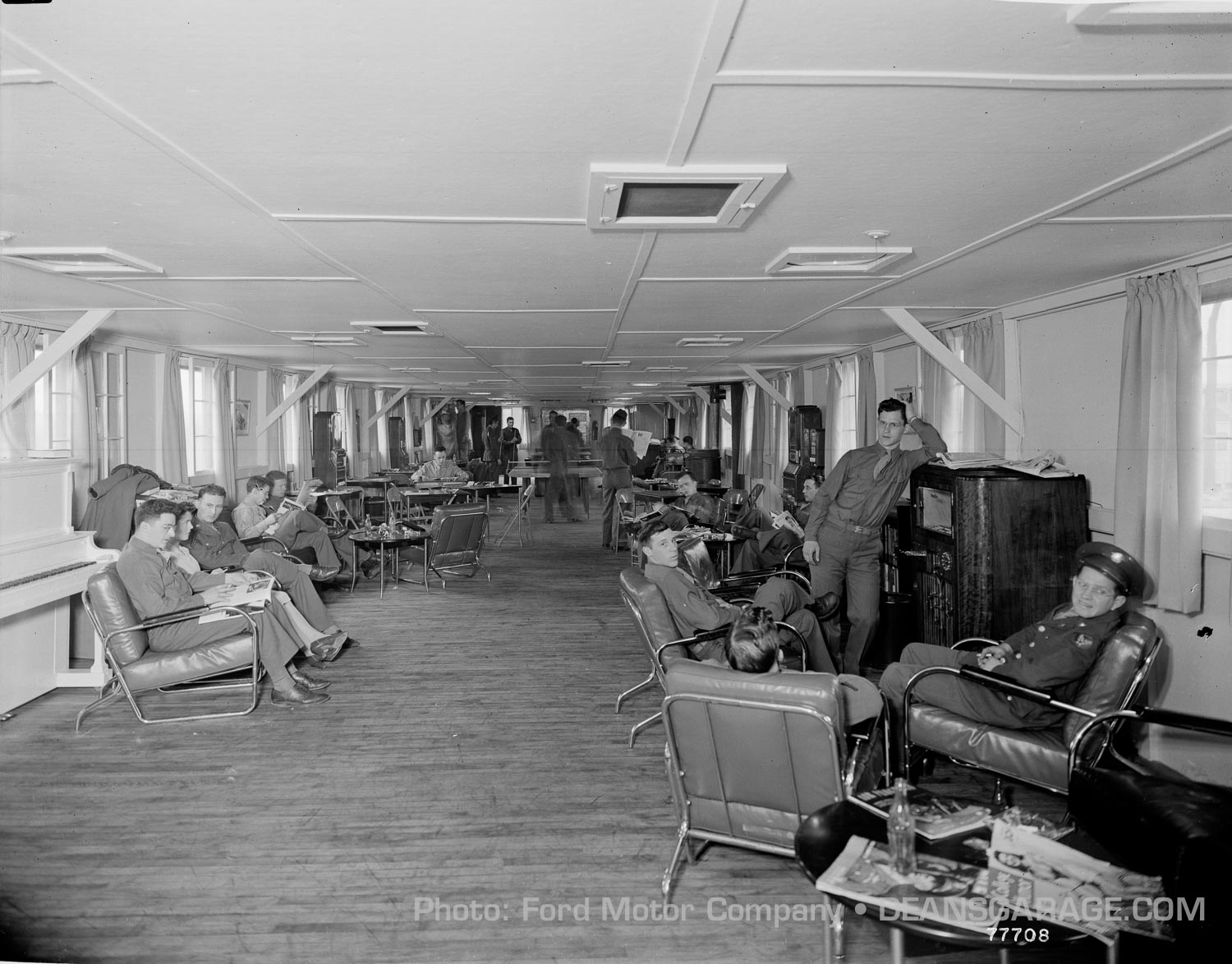
Detroit automakers were told on February 9, 1942 to cease production of civilian vehicles. With that the Rotunda was also closed to the public and during the war was used by the military for office space. Barracks were constructed behind the Rotunda for servicemen attending the Ford Service School.
After the war the Rotunda was used for business meetings, press briefings and dealer meetings.
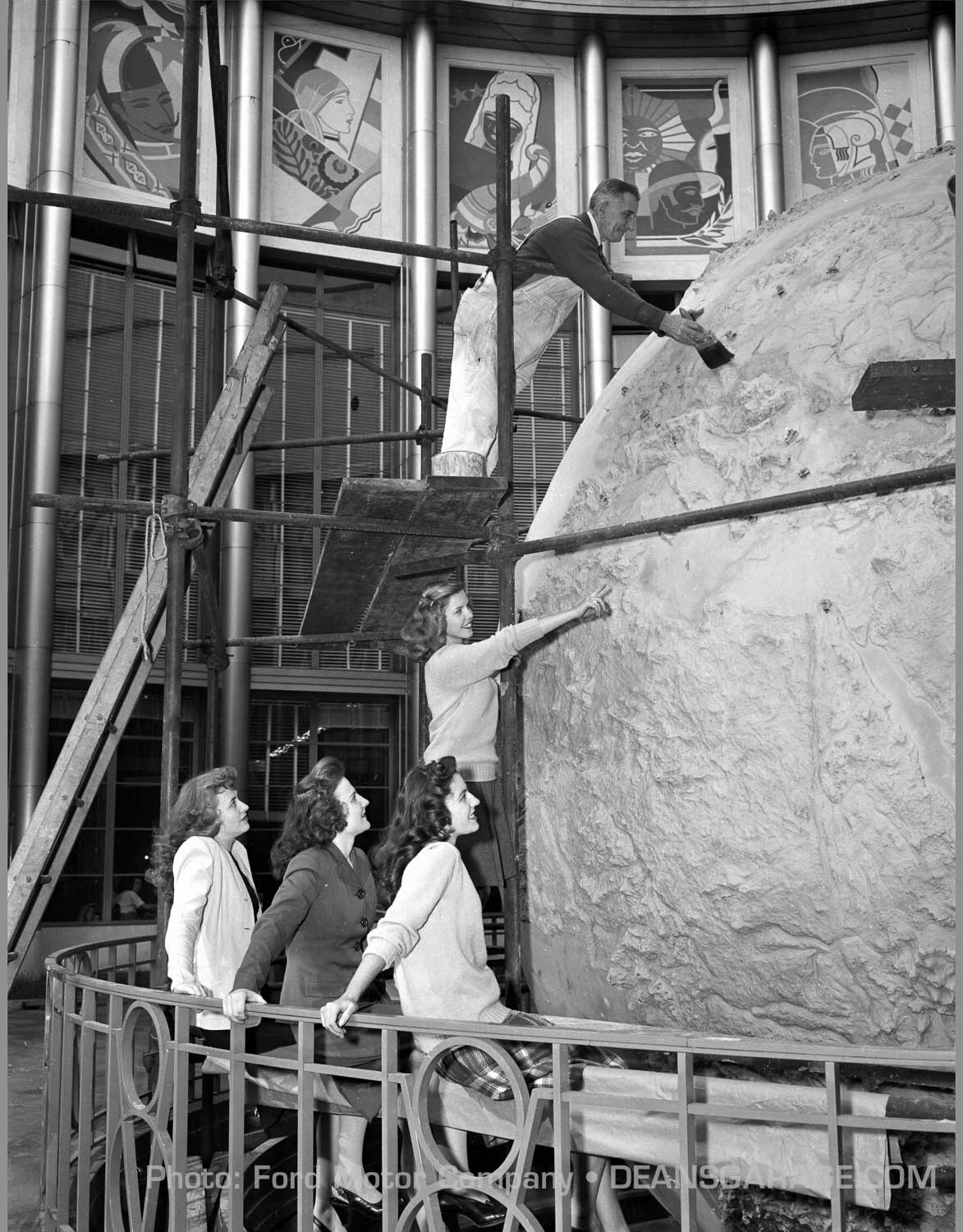
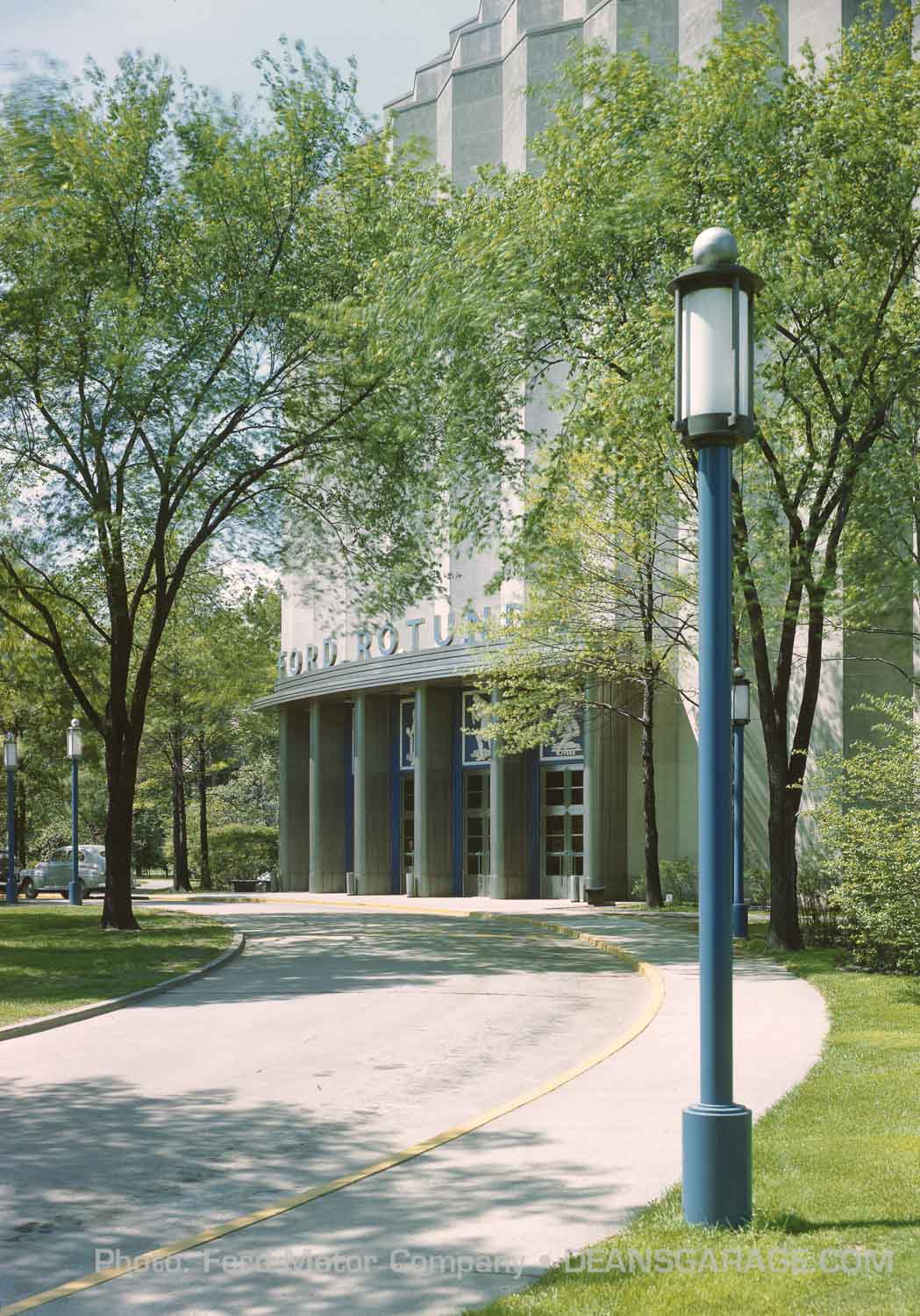
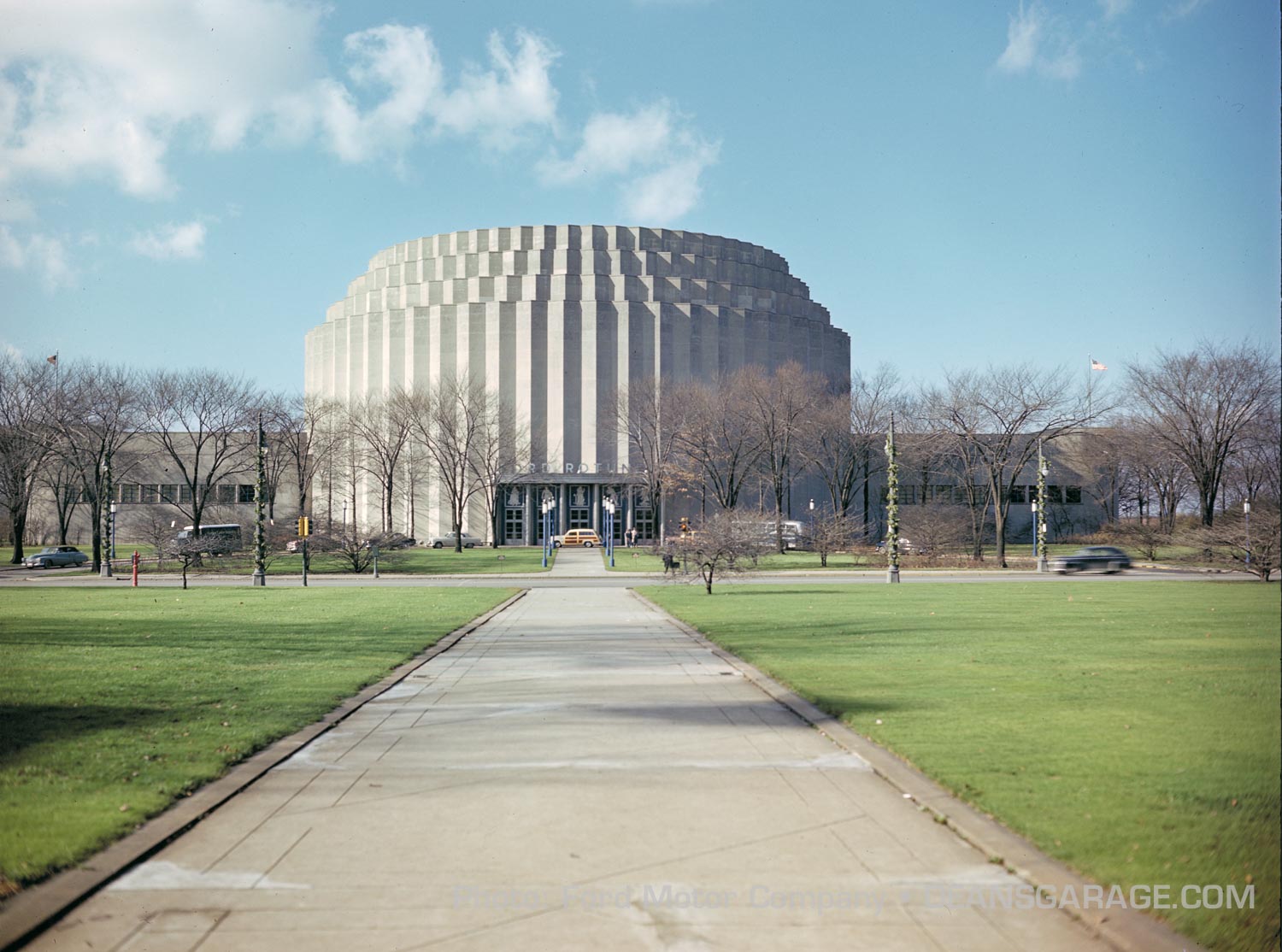
In the above three pictures we see crews cleaning the globe in the center of the Rotunda in 1944, and as it appeared in 1948 and 1950 respectively.
A decision was made by Henry Ford II in 1952 to completely remodel, update and renovate the Rotunda in anticipation of celebrating Ford’s 50th Anniversary in 1953.
For additional enclosed floor space the open air center was covered with a Geodesic Dome created by R. Buckminster Fuller. The lightweight dome was 93-feet in diameter with aluminum struts and tinted plastic panels. It was the first commercial use of this type of unique structure.
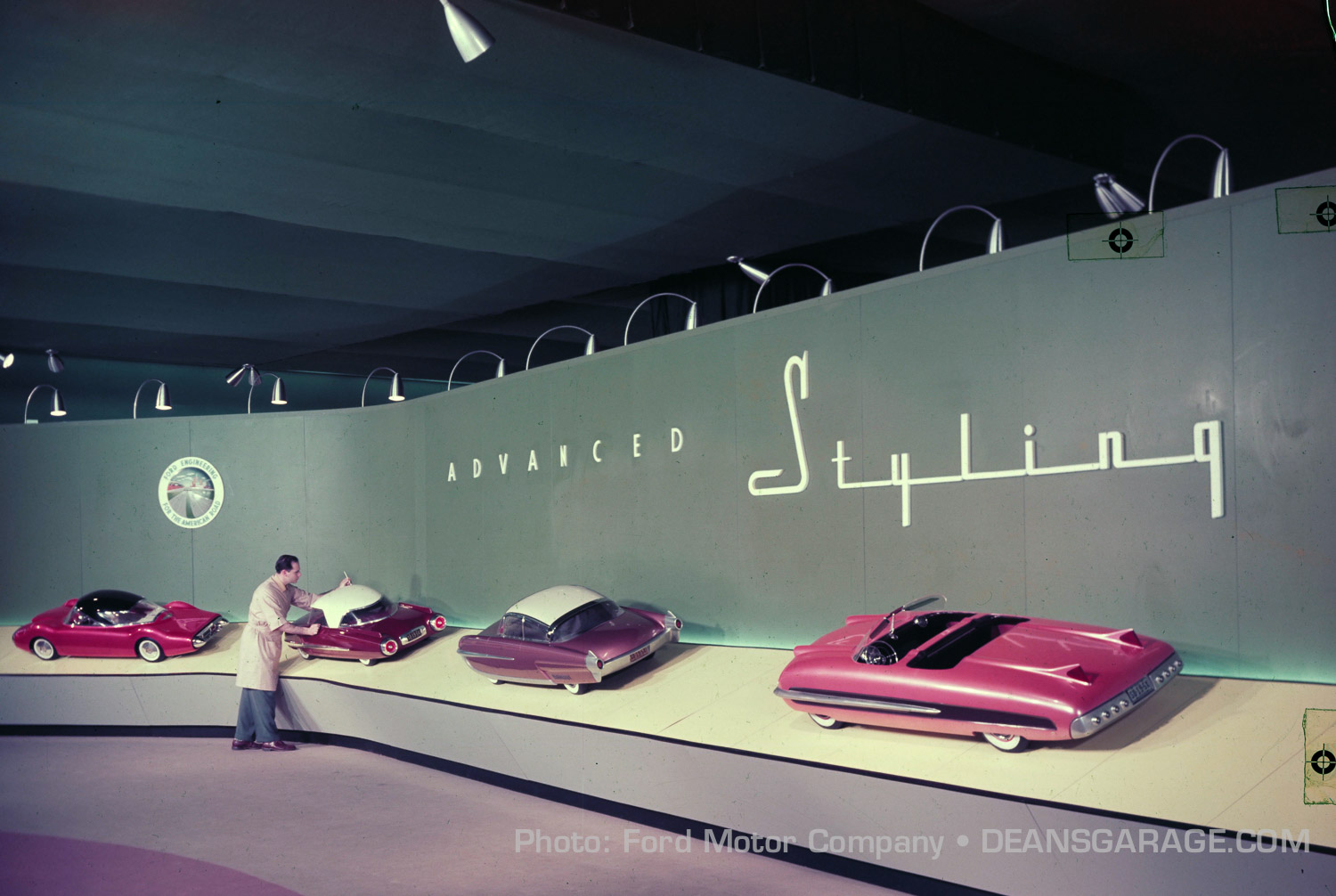
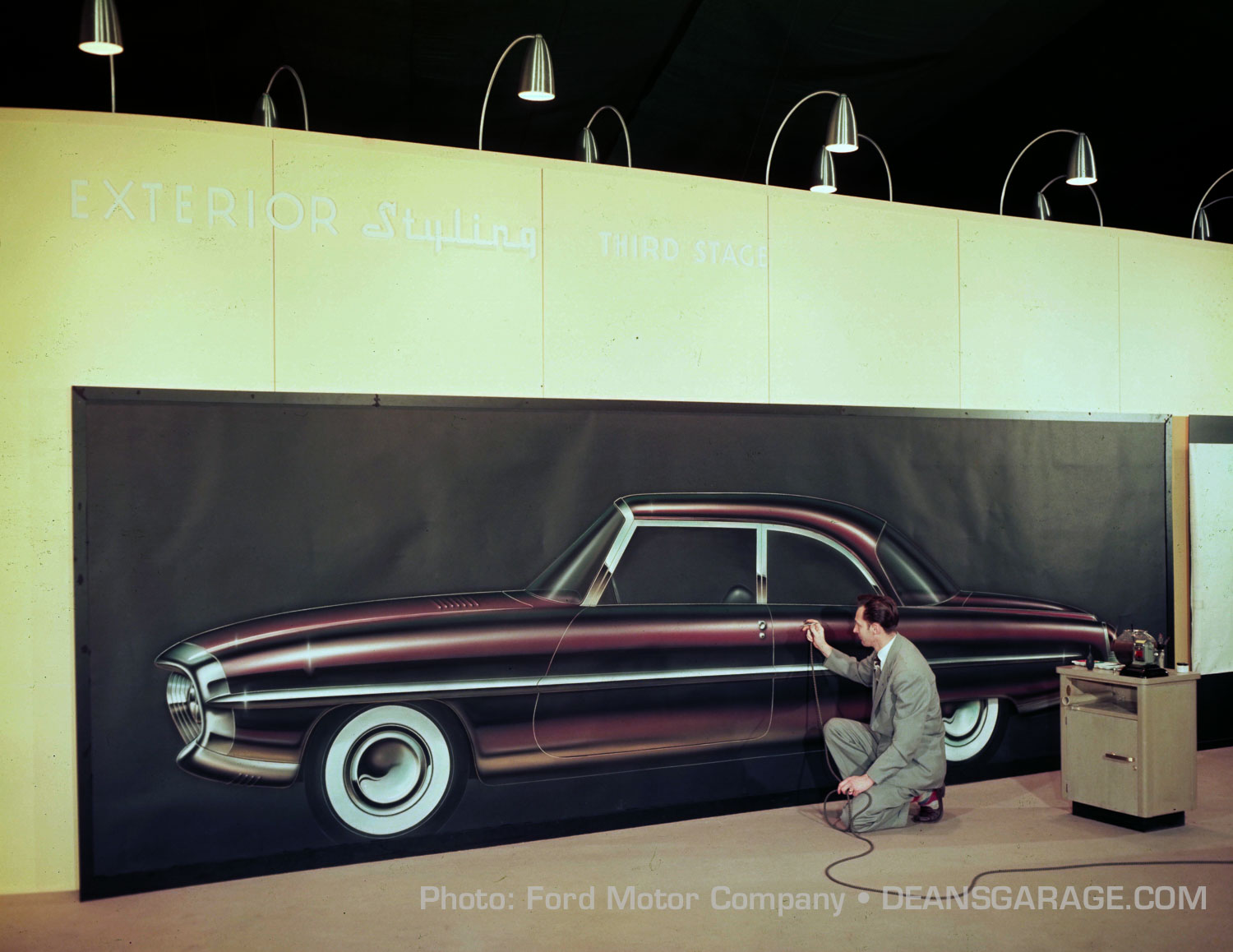
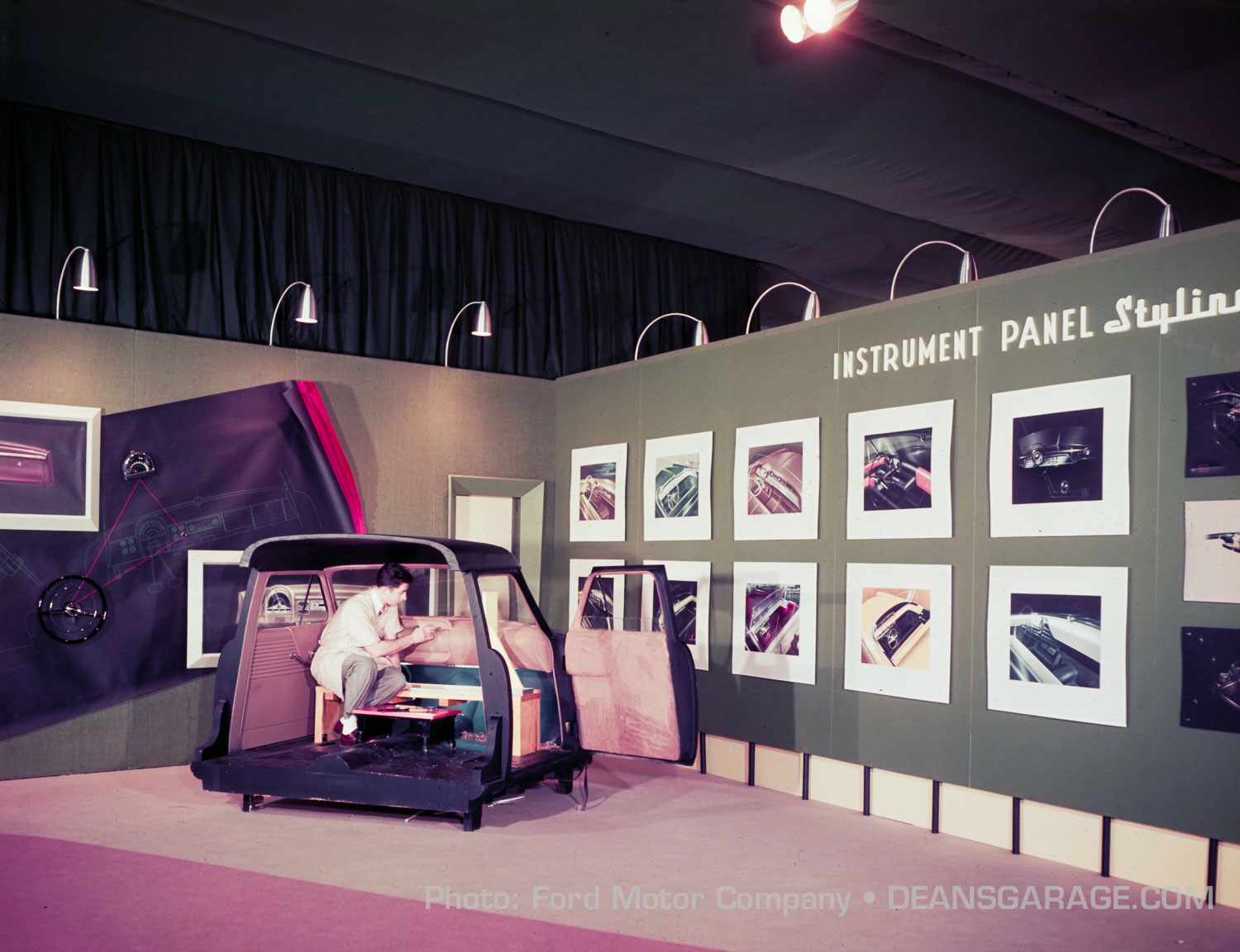
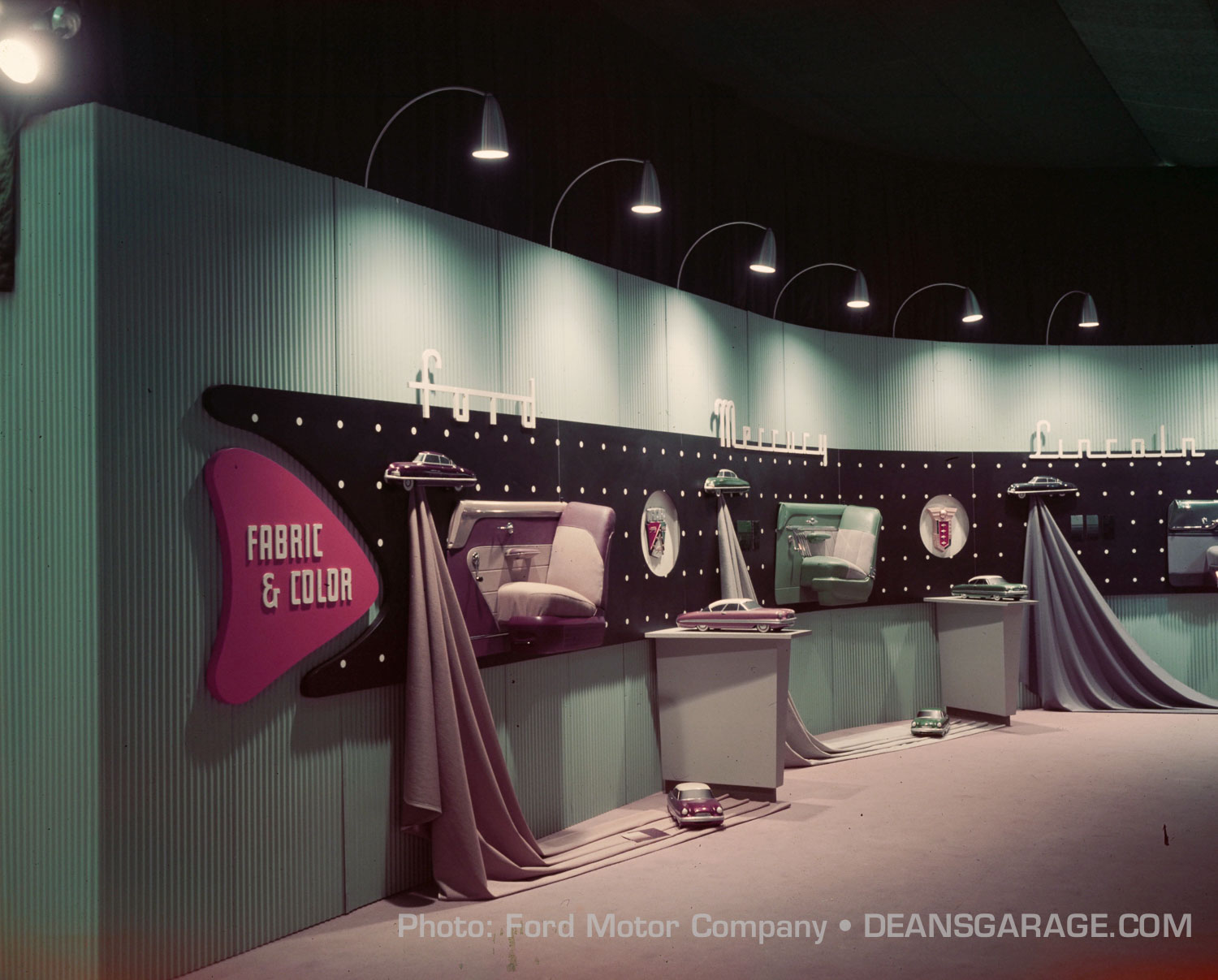
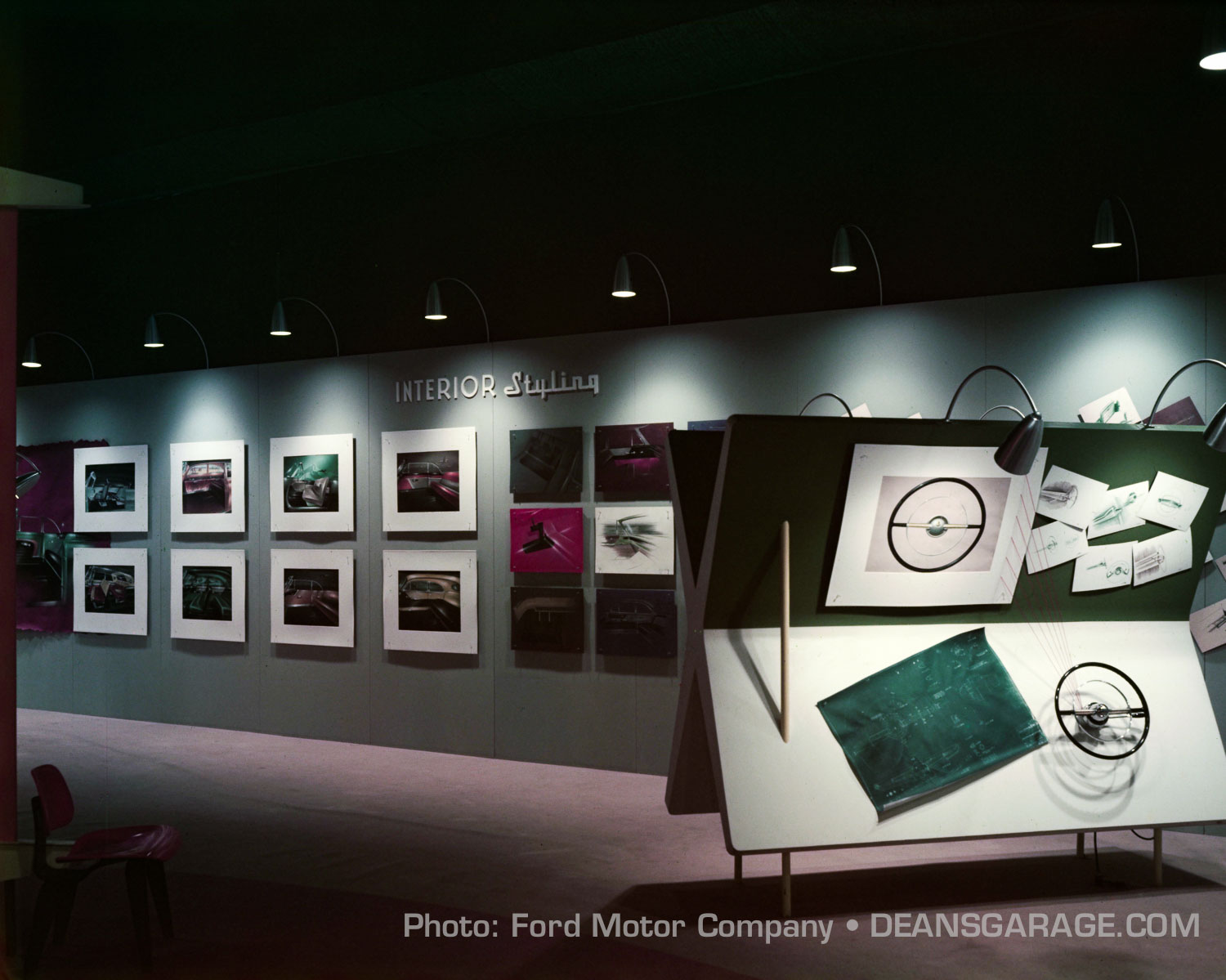
As mentioned earlier, Ford was interested in displaying to the public the importance of styling and how its various elements came together. These displays were created in 1951 to be installed in the remodeled Rotunda.
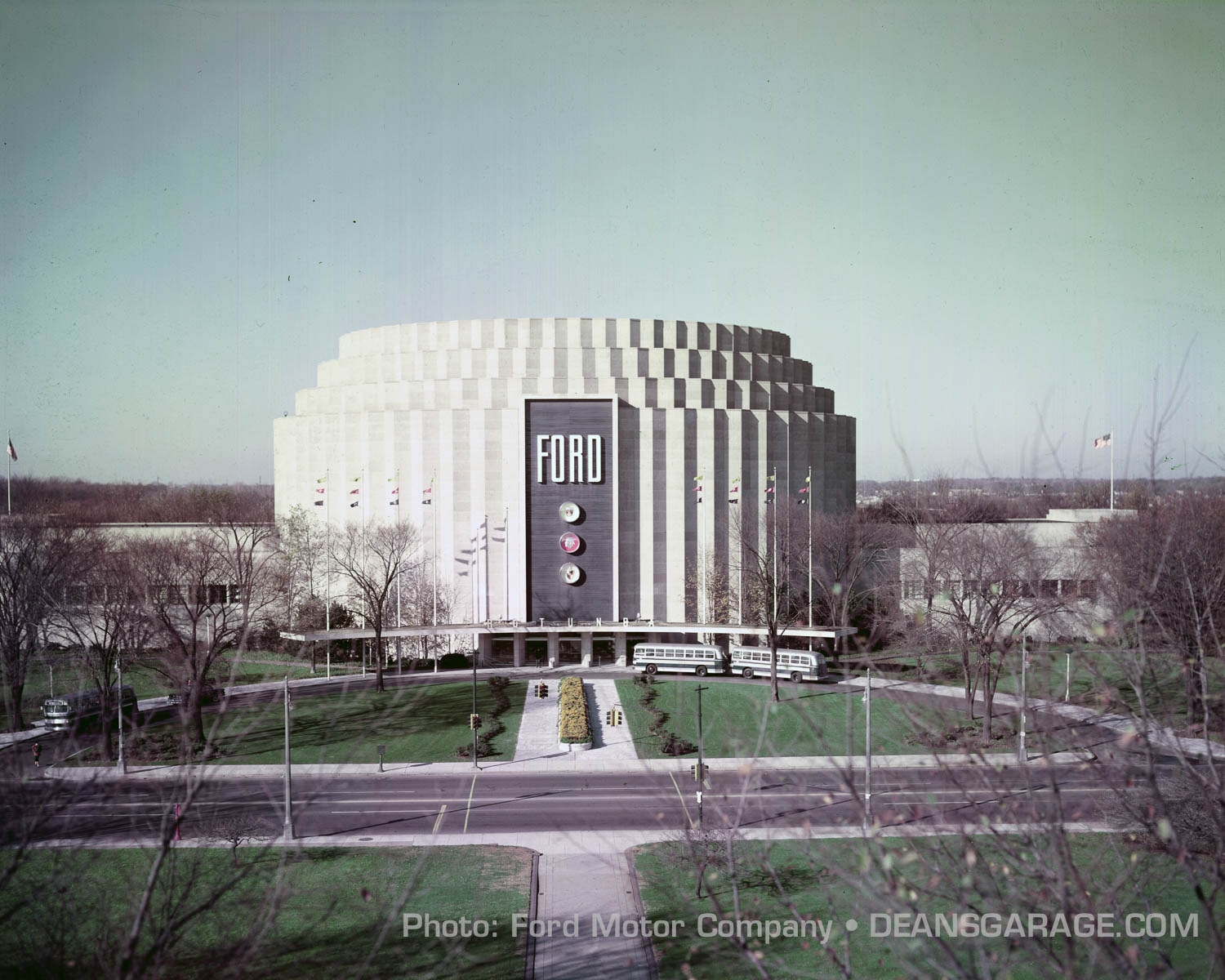
Ford celebrated its 50th year anniversary on June 16, 1953 and the Rotunda was once again opened to the public the following day. Note the entirely new front facade. The buses were used to take guests to tour the River Rouge complex which included Dearborn Assembly.
In addition to the center court and theater the floor plan was organized into four major sections.
• Research in Chemistry and Electronics
• Manufacturing Progress and Quality Control
• Design and Engineering
• Better Life and More Jobs Through the Auto Industry
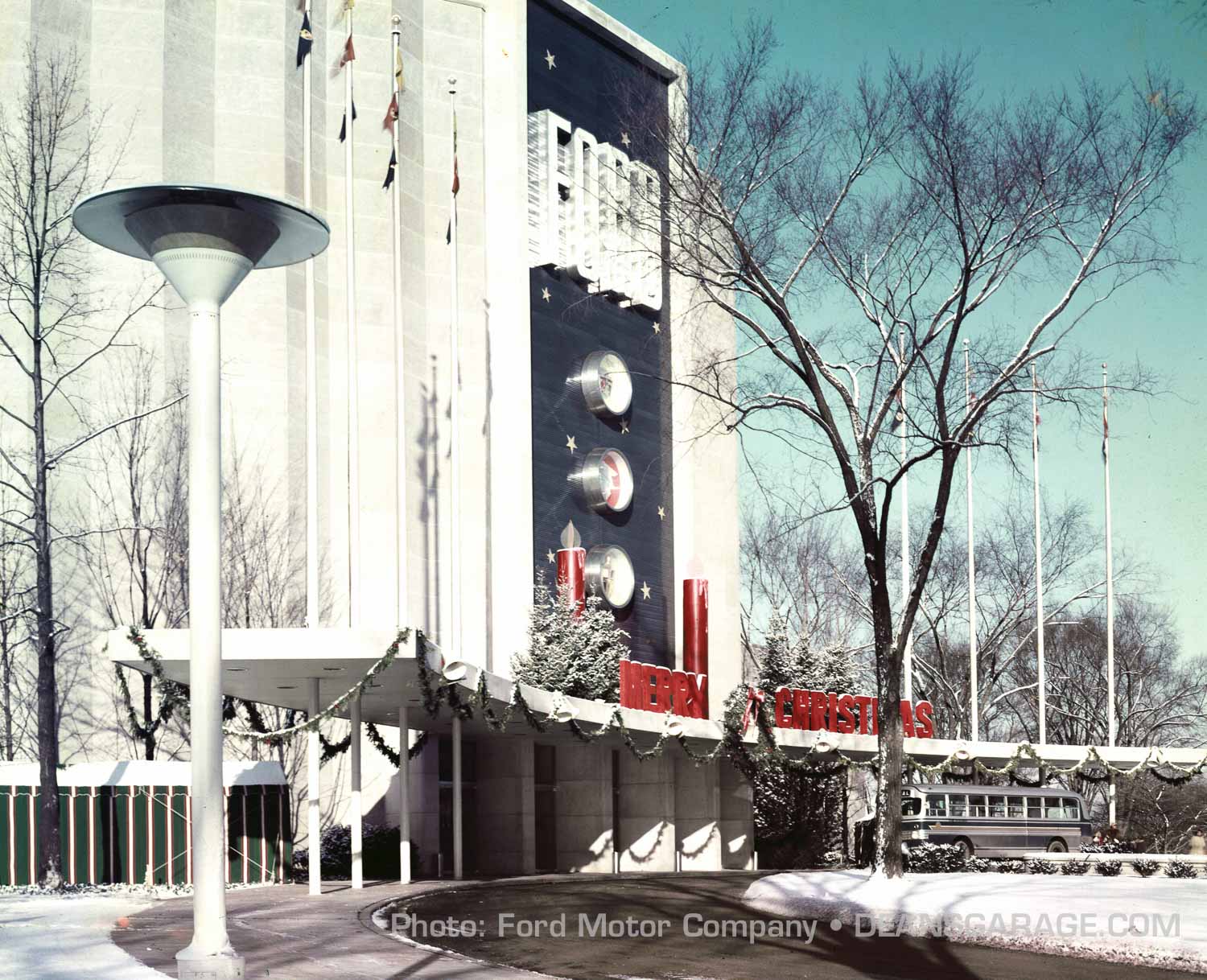
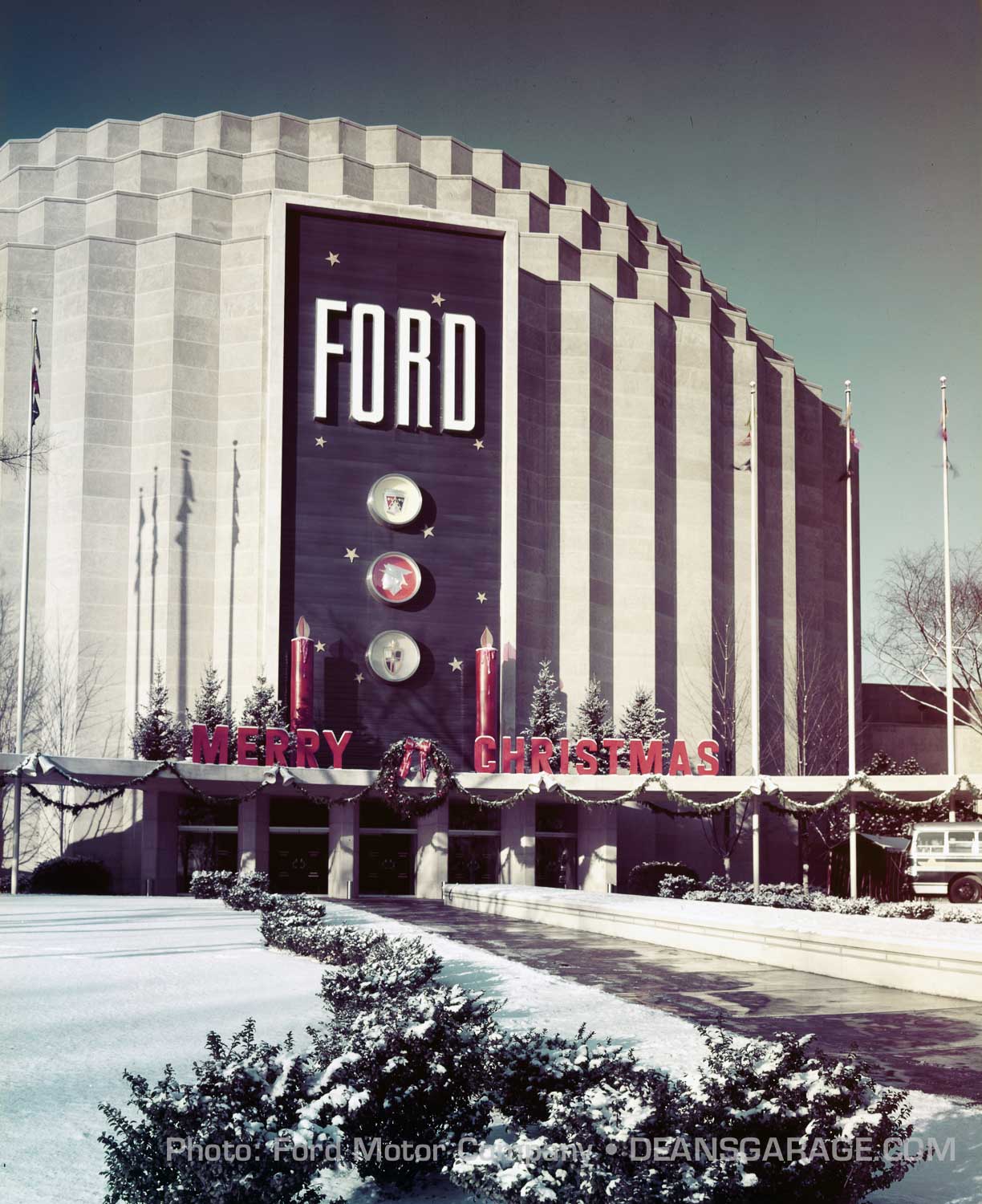
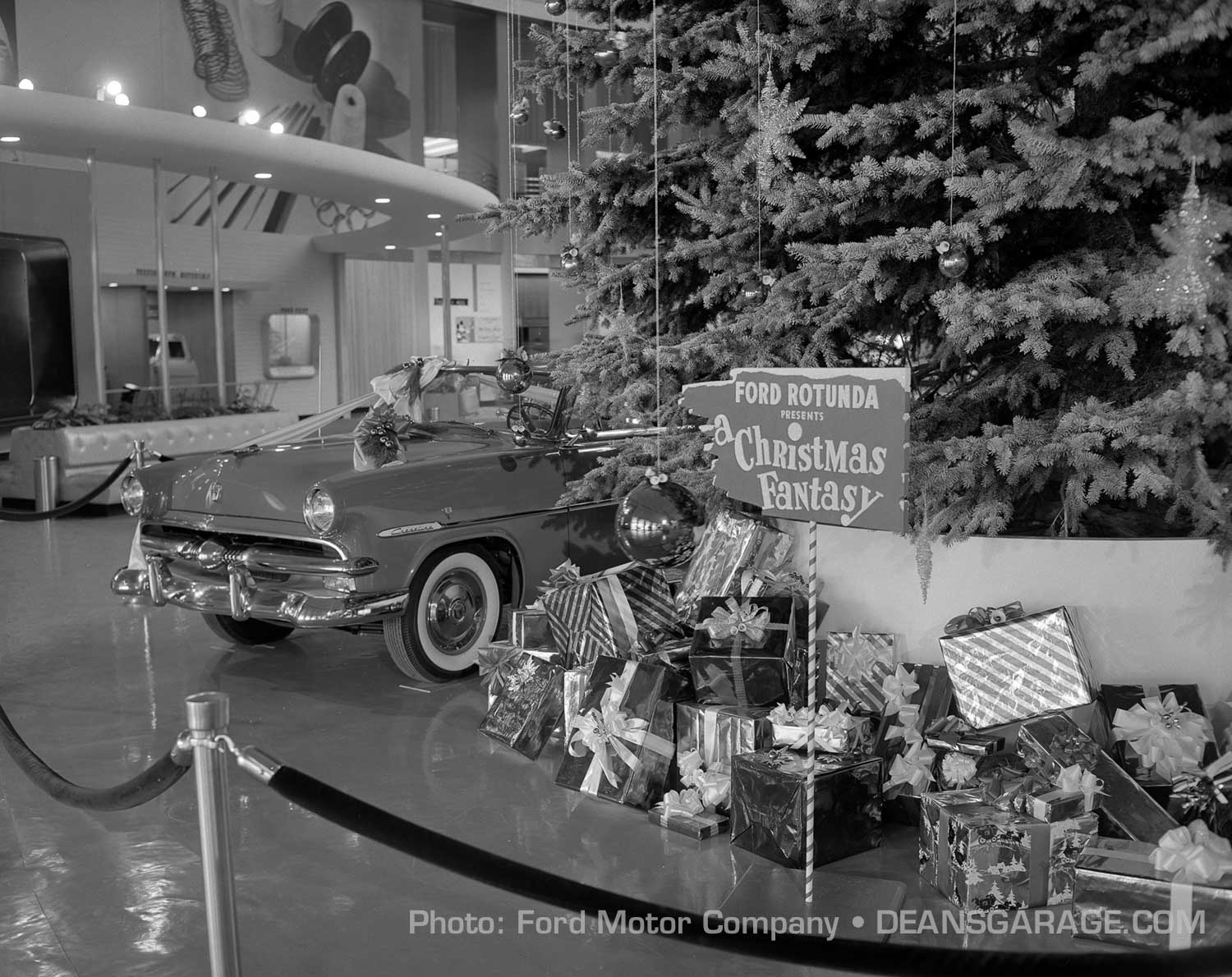
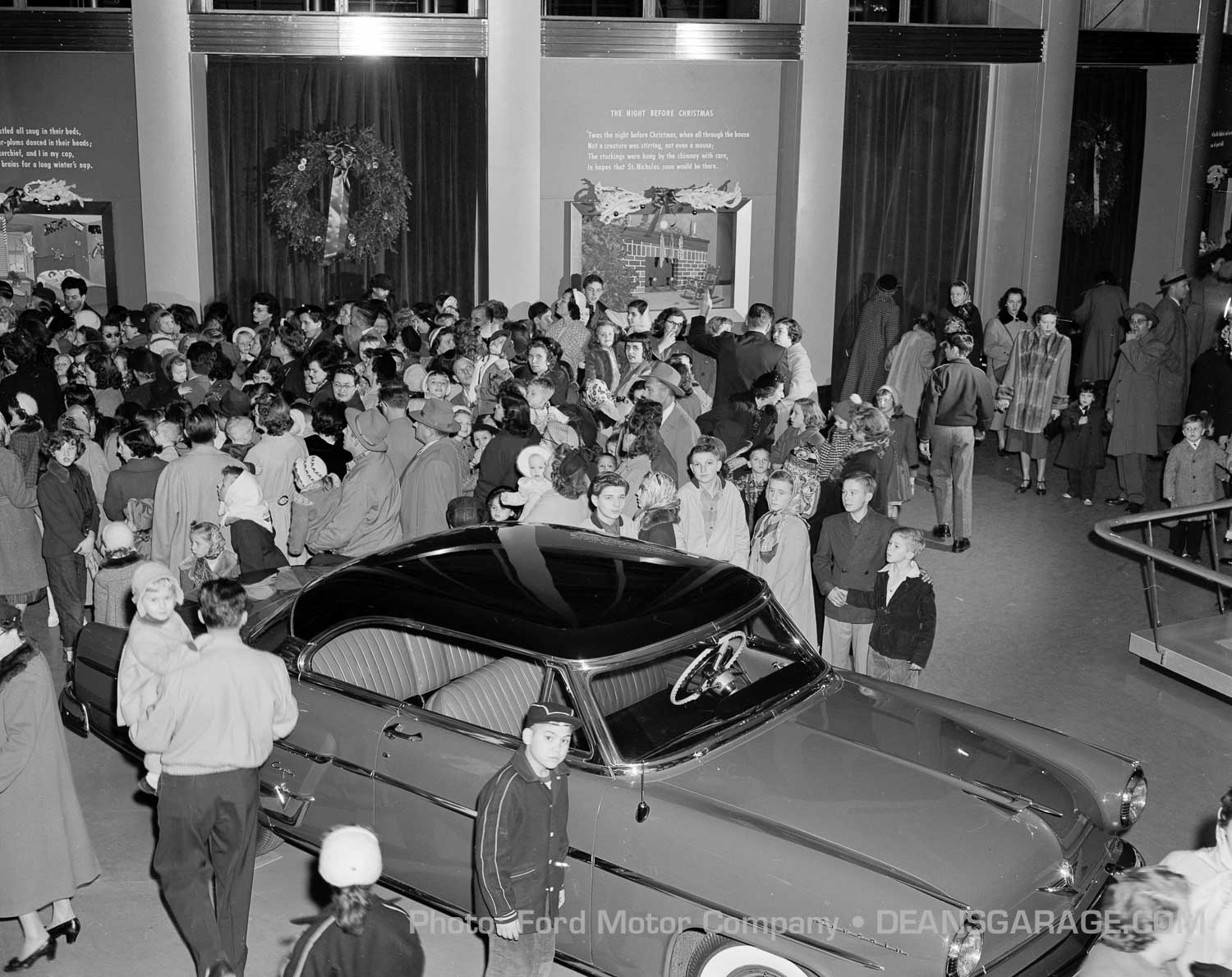
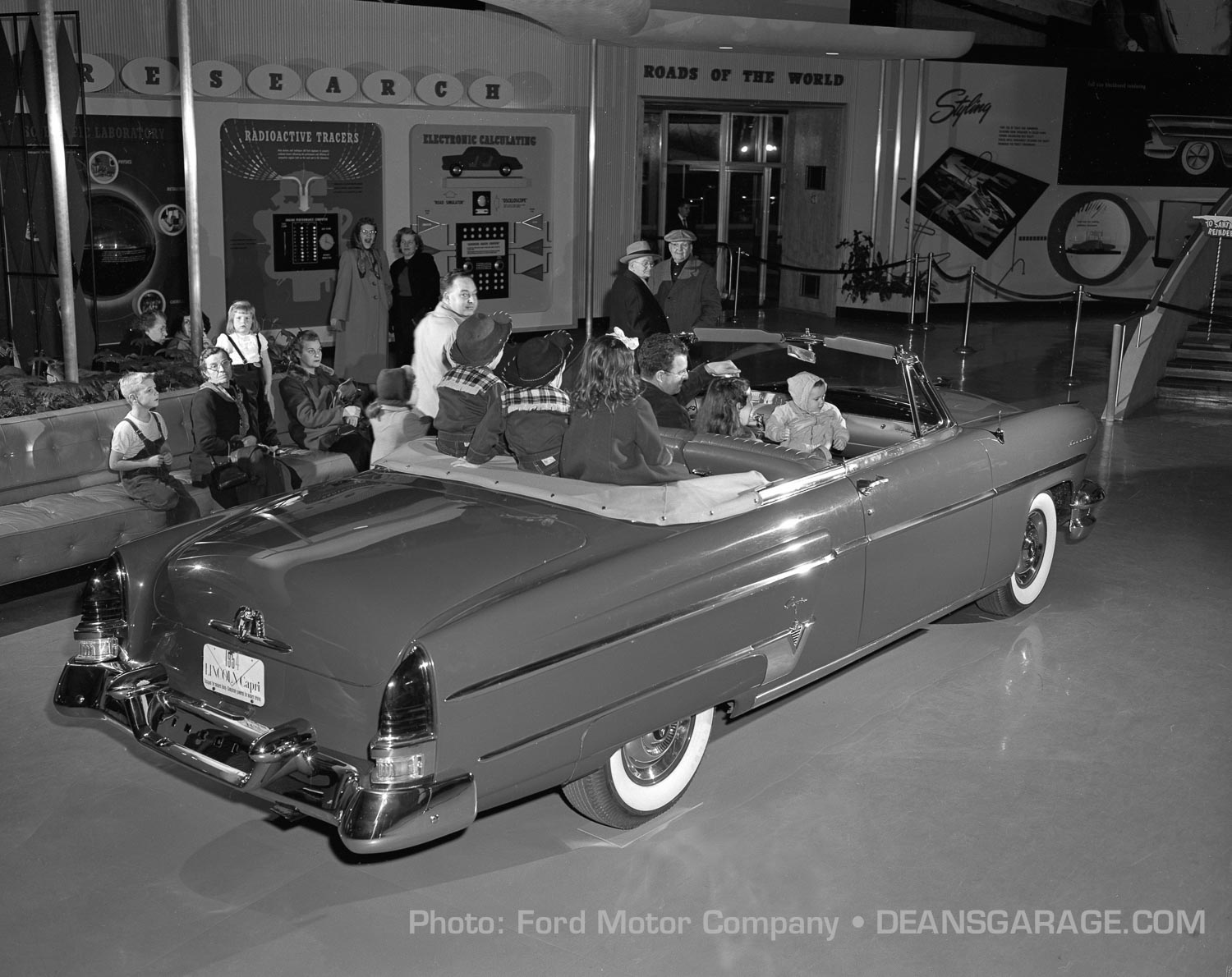
The one yearly display that was most popular was “A Christmas Fantasy.” The previous five pictures were taken during the first Christmas Fantasy in December of 1953. Just inside the front door was a 40-foot tall Christmas tree adorned with some 17,000 lights. There were numerous Christmas themed displays and was highlighted by Santa’s Castle. Over a half a million people visited that year. From 1953 to 1961 over six million people visited “A Christmas Fantasy.”
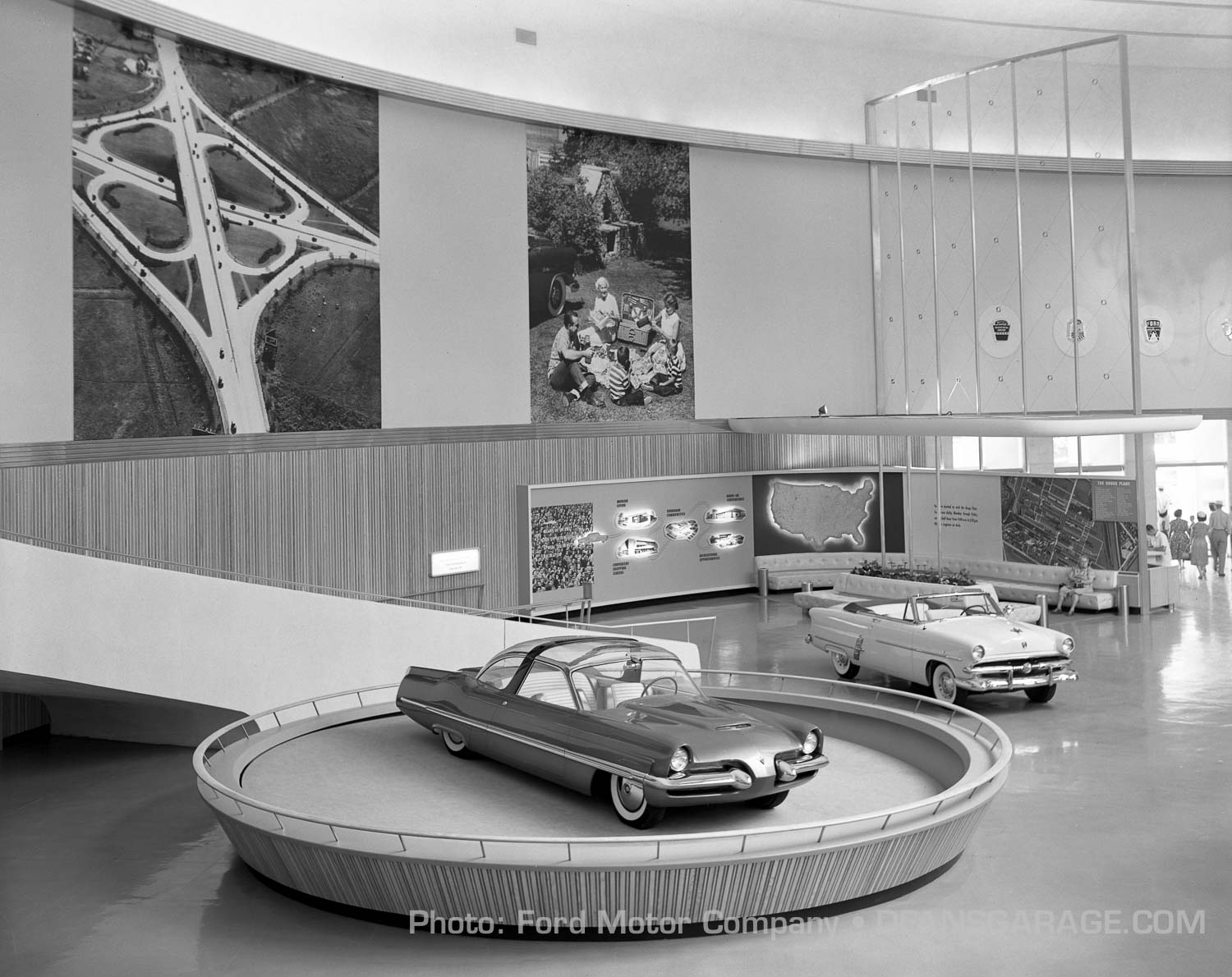
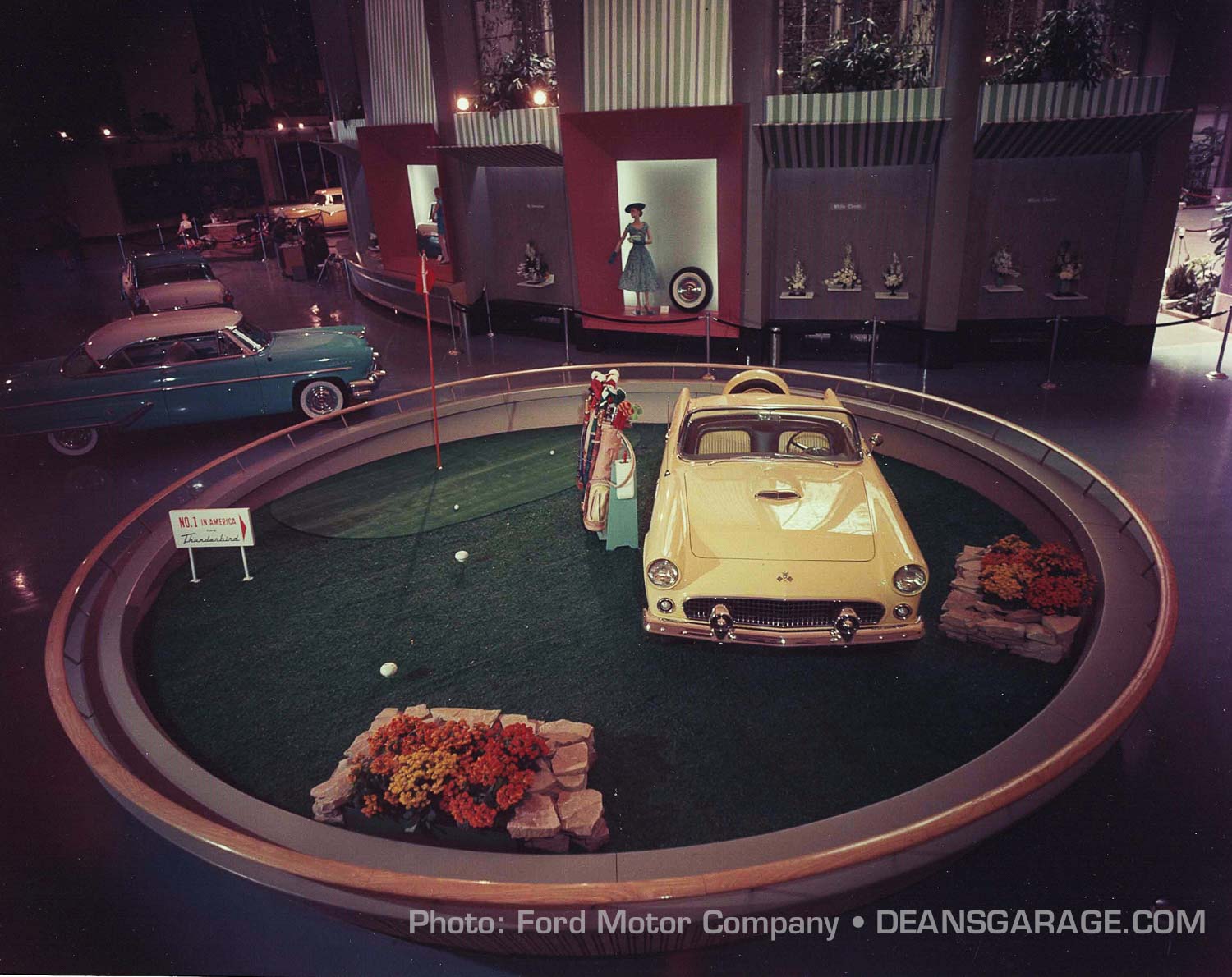
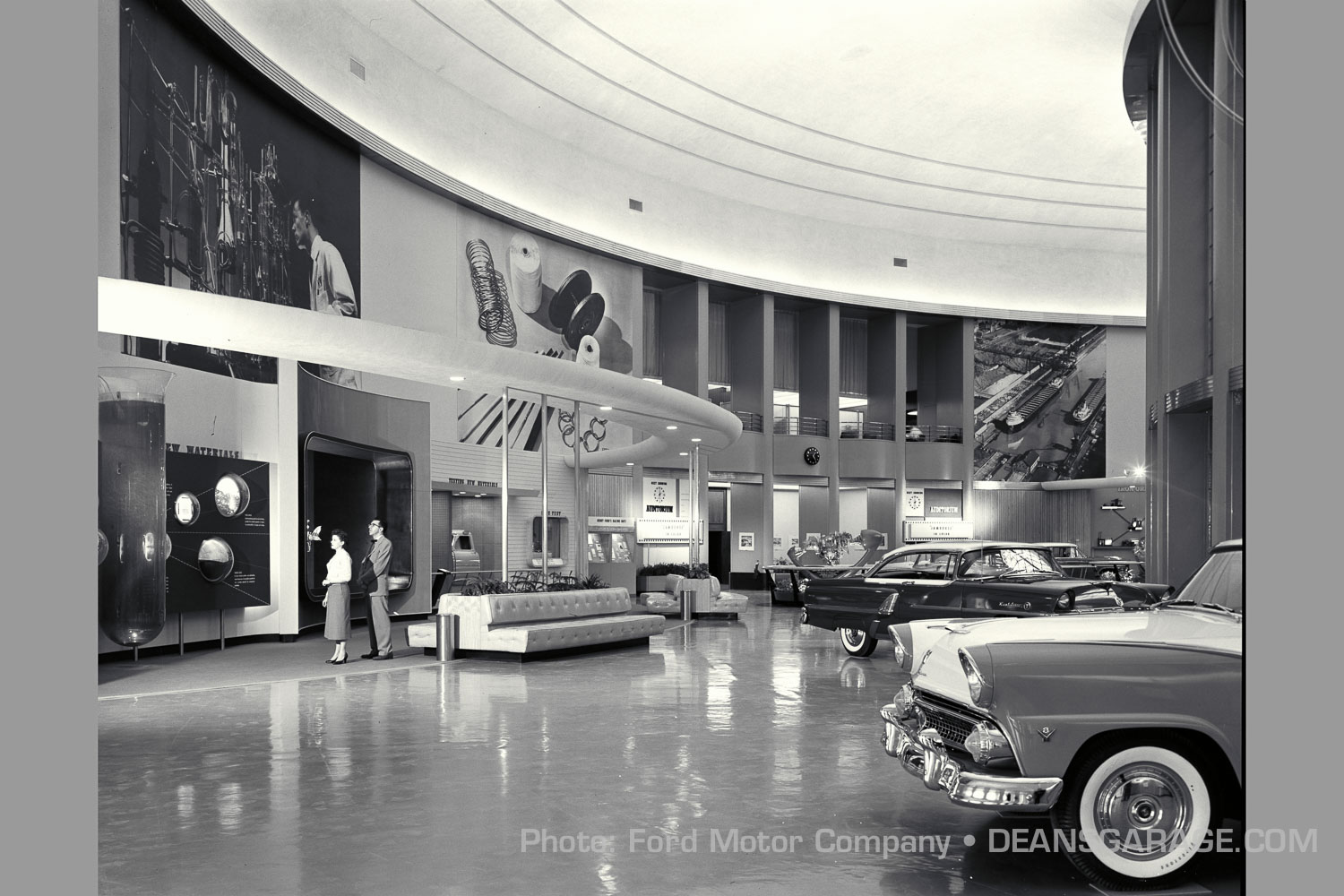
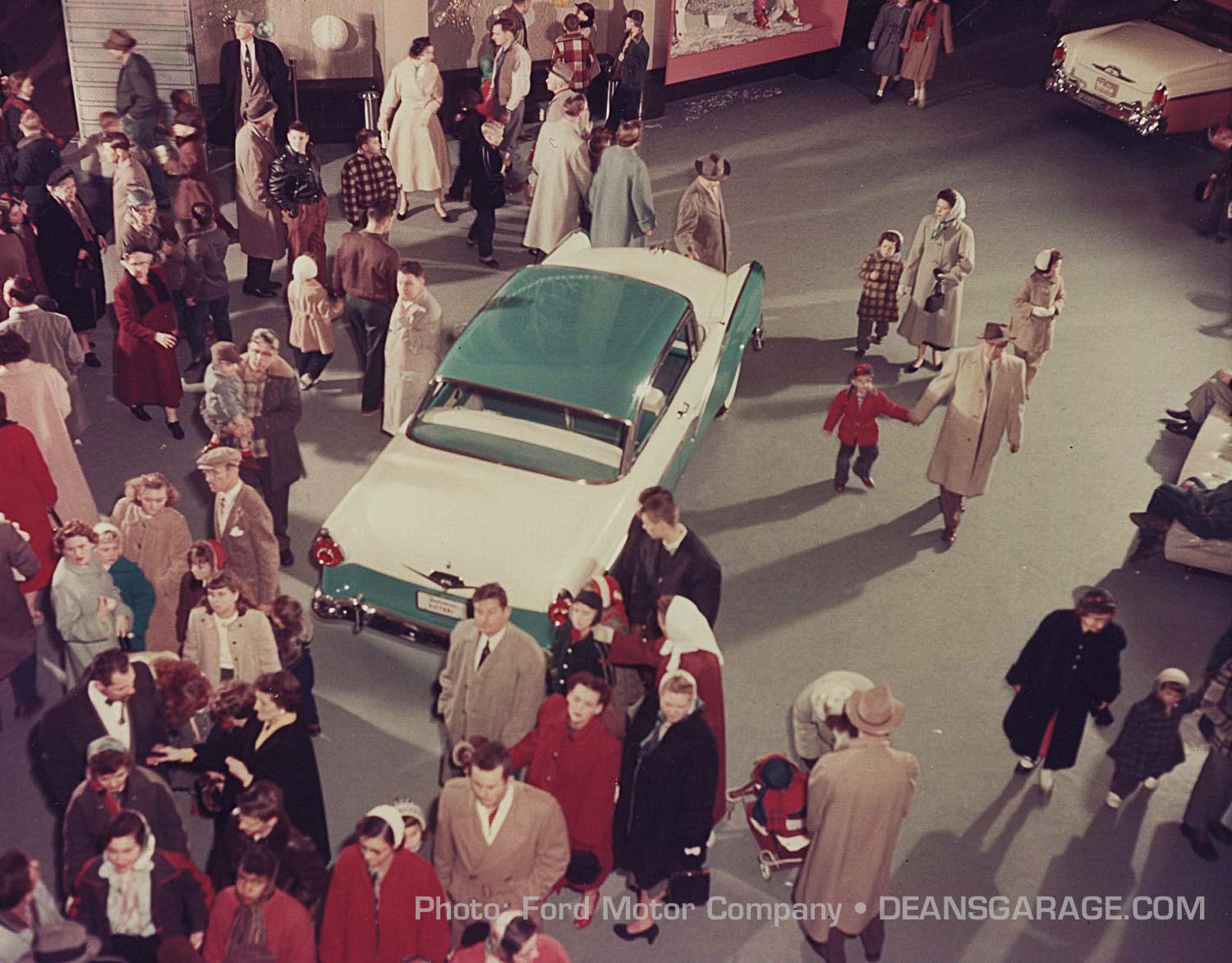
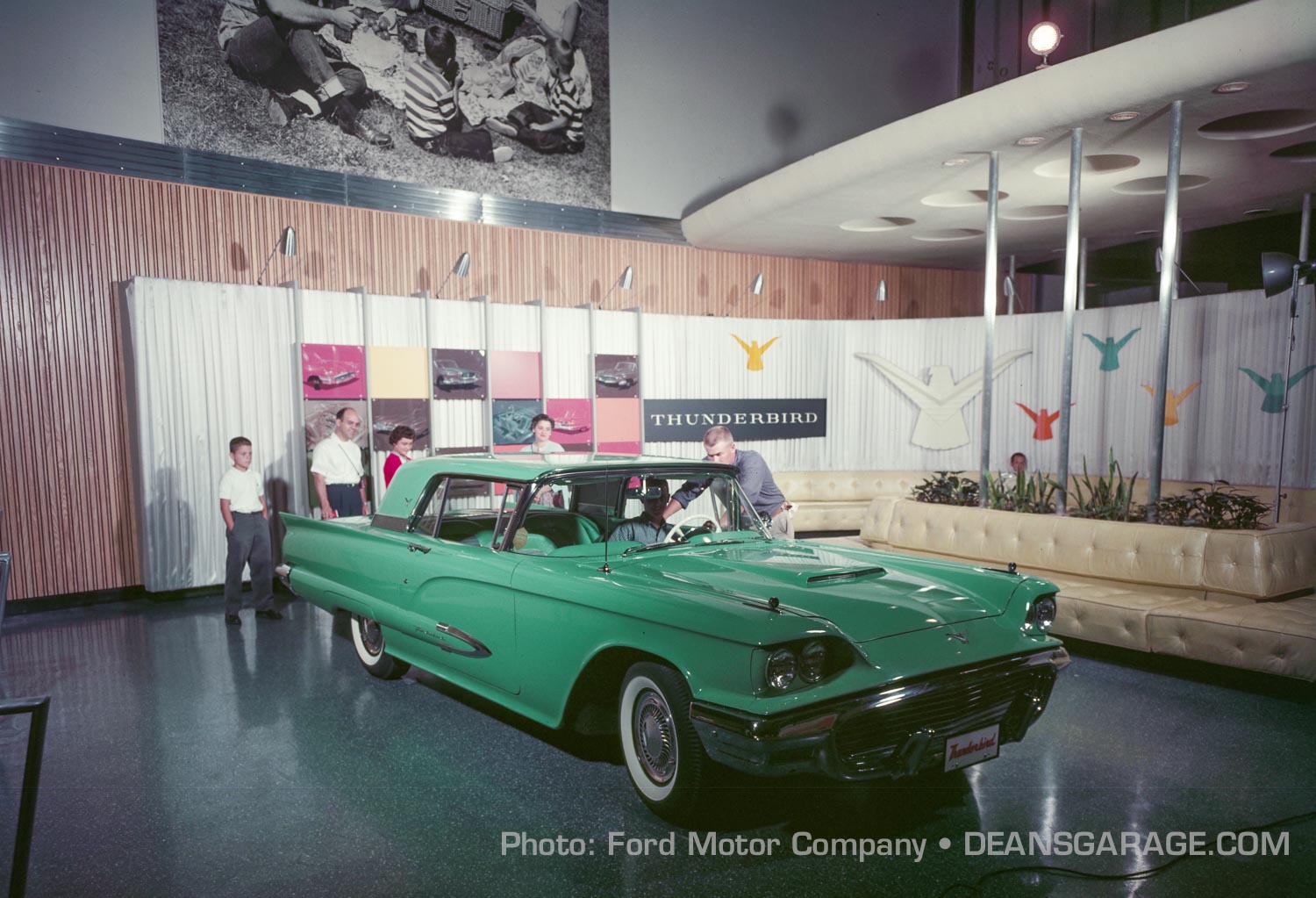
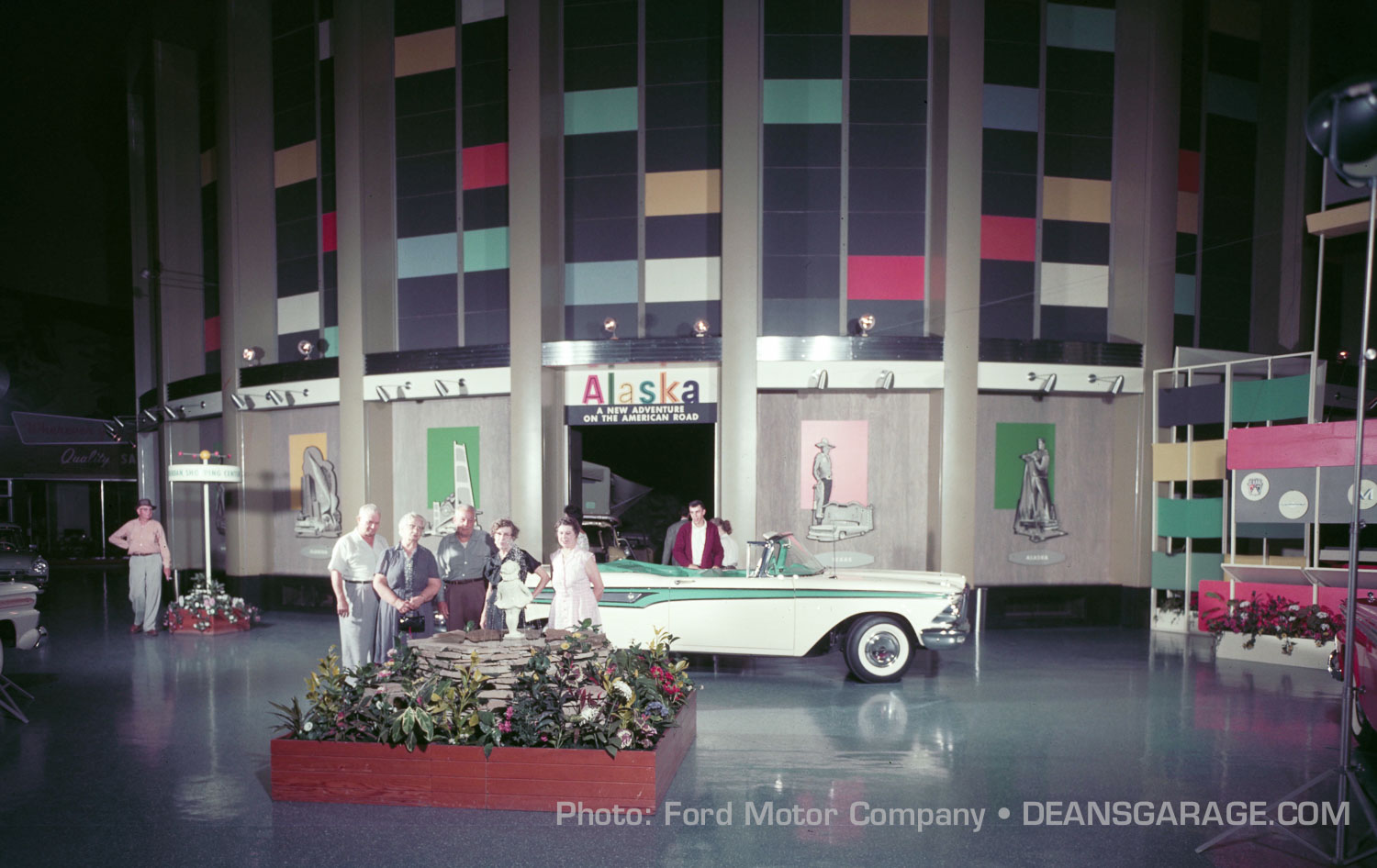
Naturally, Ford used the Rotunda to highlight the current product offerings. Over the years numerous themes were also highlighted such as a Hawaiian Display and an Alaskan Display in 1958. Note the entry to the Alaskan display behind the ’59 Edsel in the last picture.
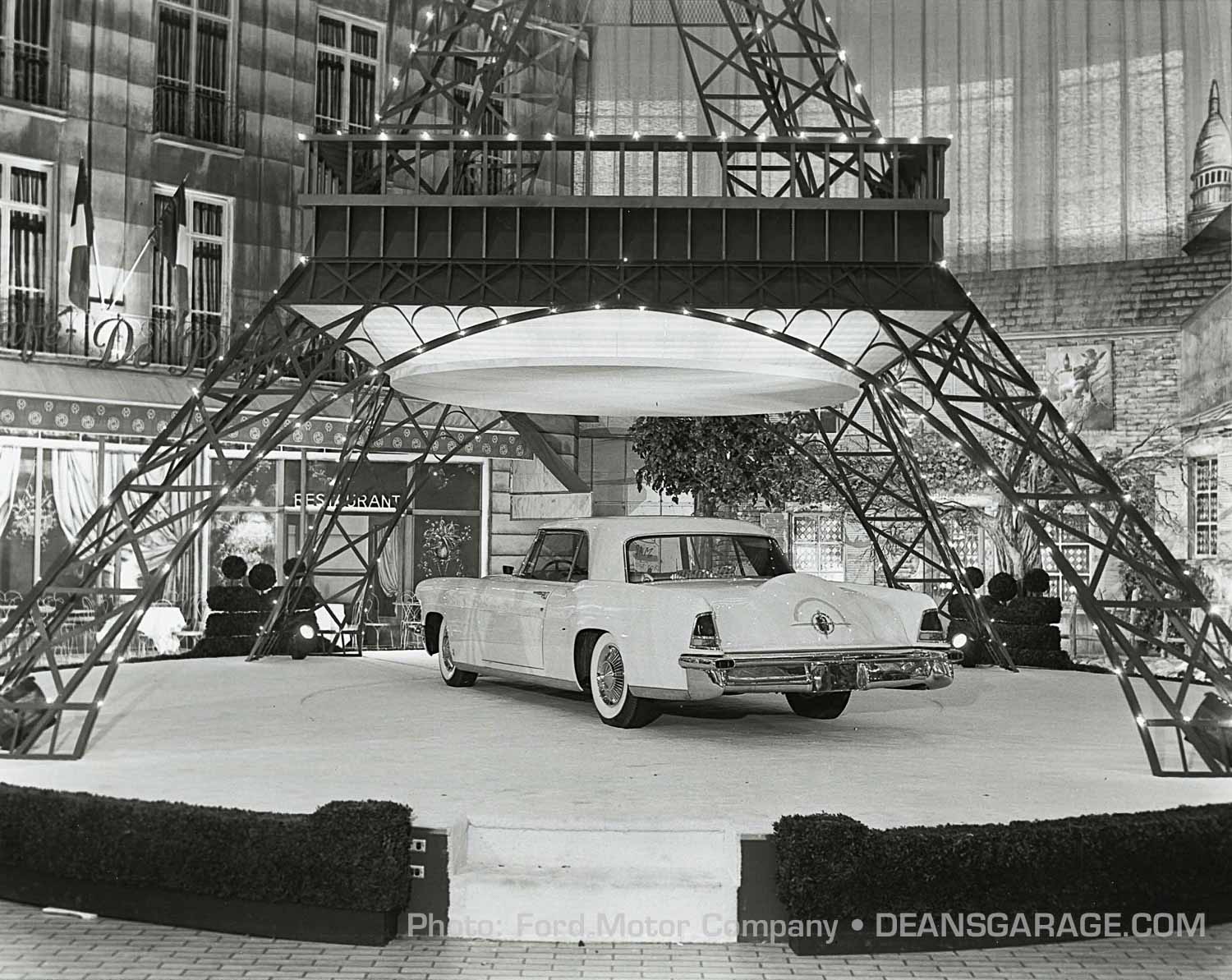
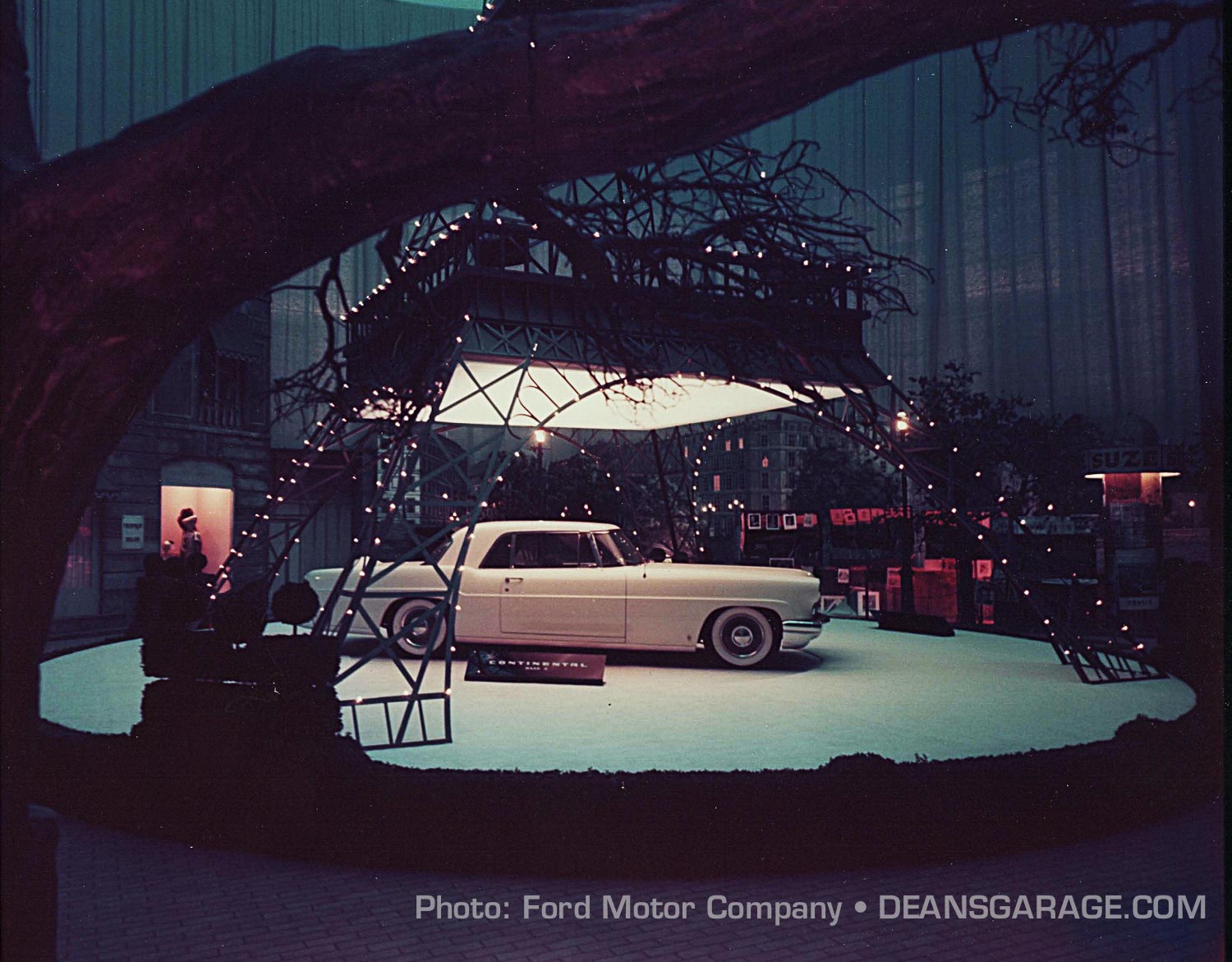
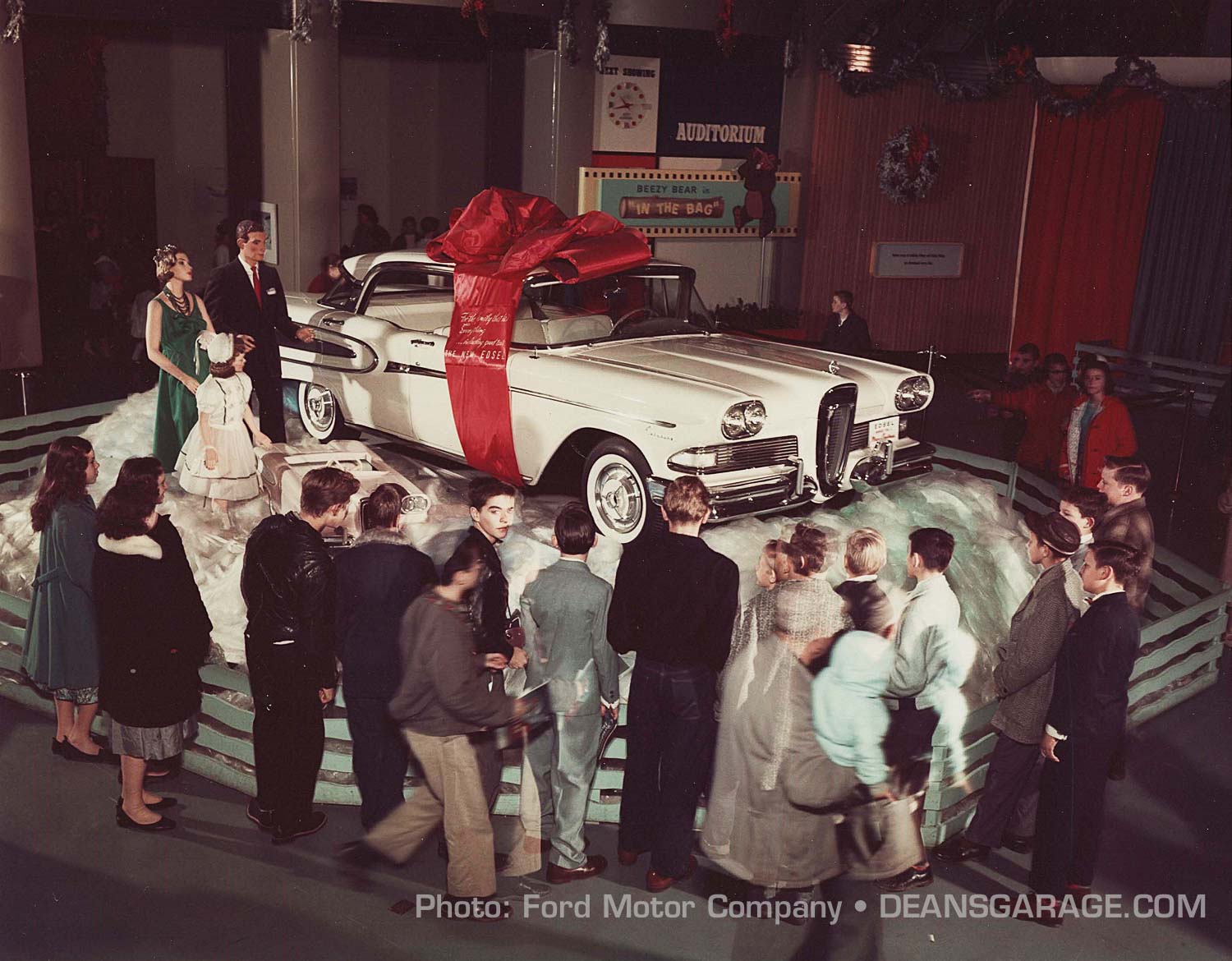
The Rotunda was also a vehicle used for introducing brand new models to the public such as the Continental Mark II. First introduced at the Paris Auto Show in October 1955. That introduction was recreated at the Rotunda under a 100-foot high Eiffel Tower replica on a Parisian street scene.
The new ’58 Edsel was also highlighted shortly after its September 1957 introduction to the public. This picture taken December 17, 1957.
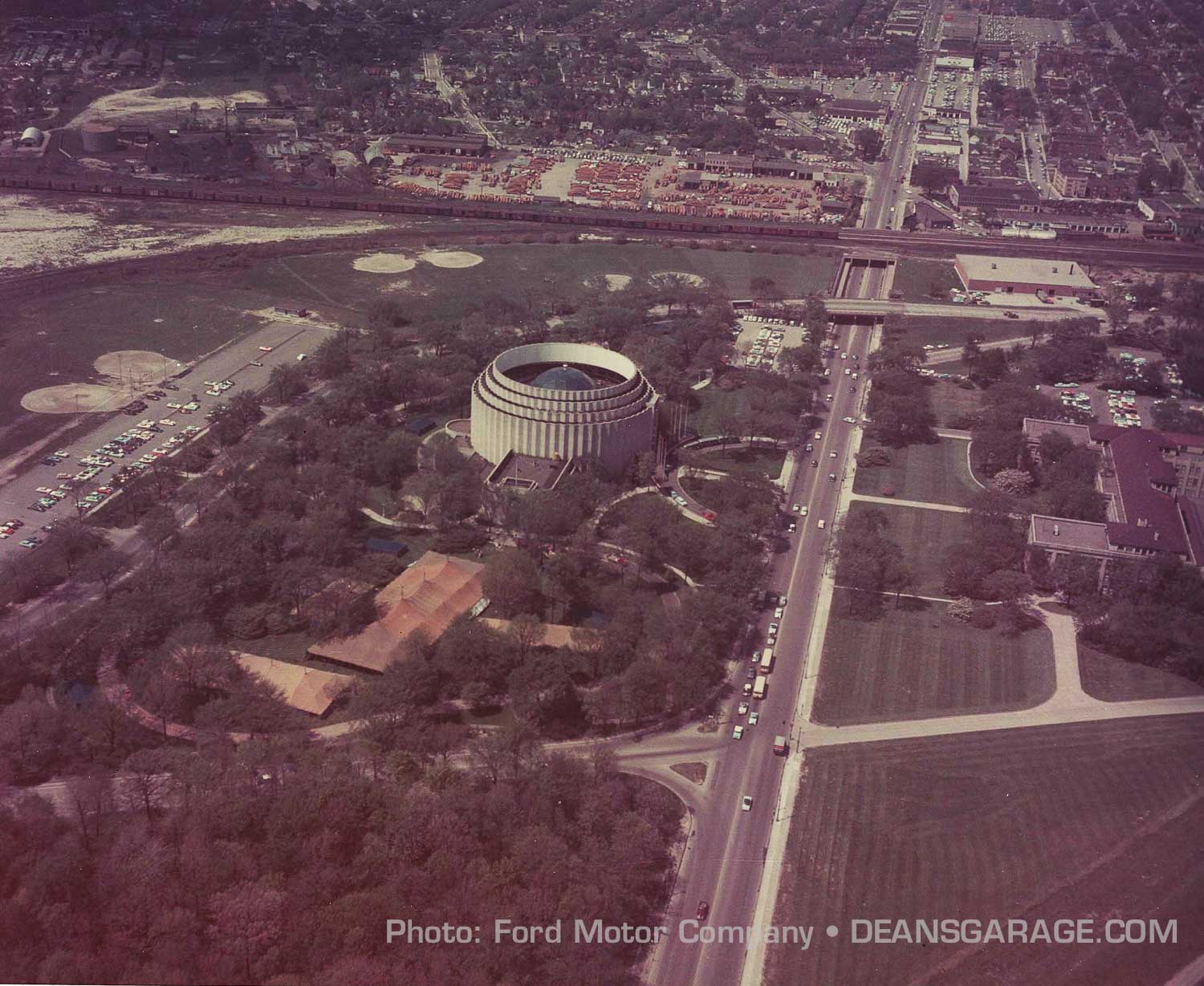
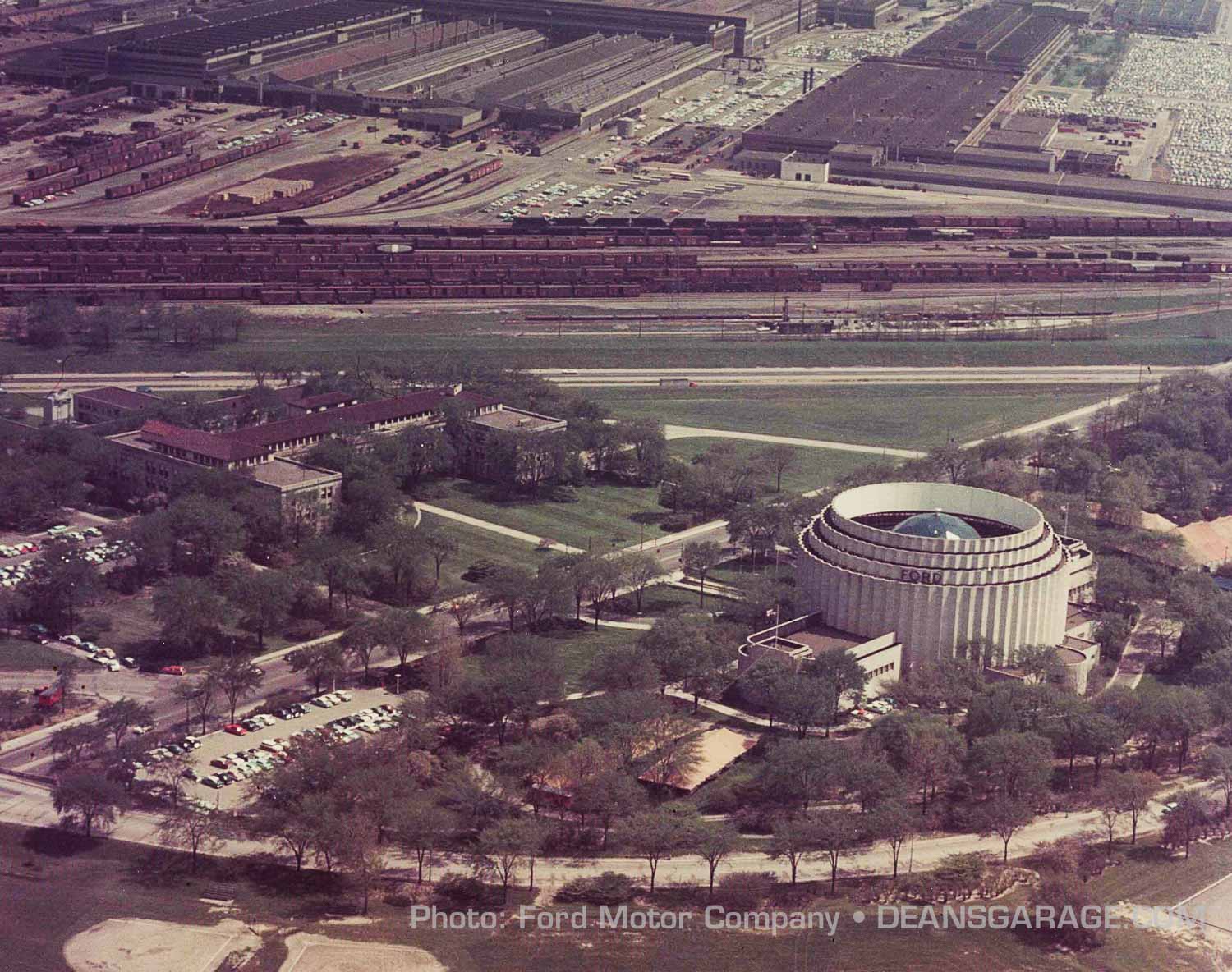
These two pictures, taken in May of 1956, help define the location of the Rotunda. That’s Schaefer Road running north-south bisecting the first photo. On the back side is Rotunda Drive which curves around and crosses Schaefer with a bridge. The Administration Building is clearly visible across Schaefer. Once the new “Glass House” headquarters were opened in 1957, the building was then known as The Lincoln-Mercury Building.
Note that the Geodesic Dome is clearly visible in both pictures.
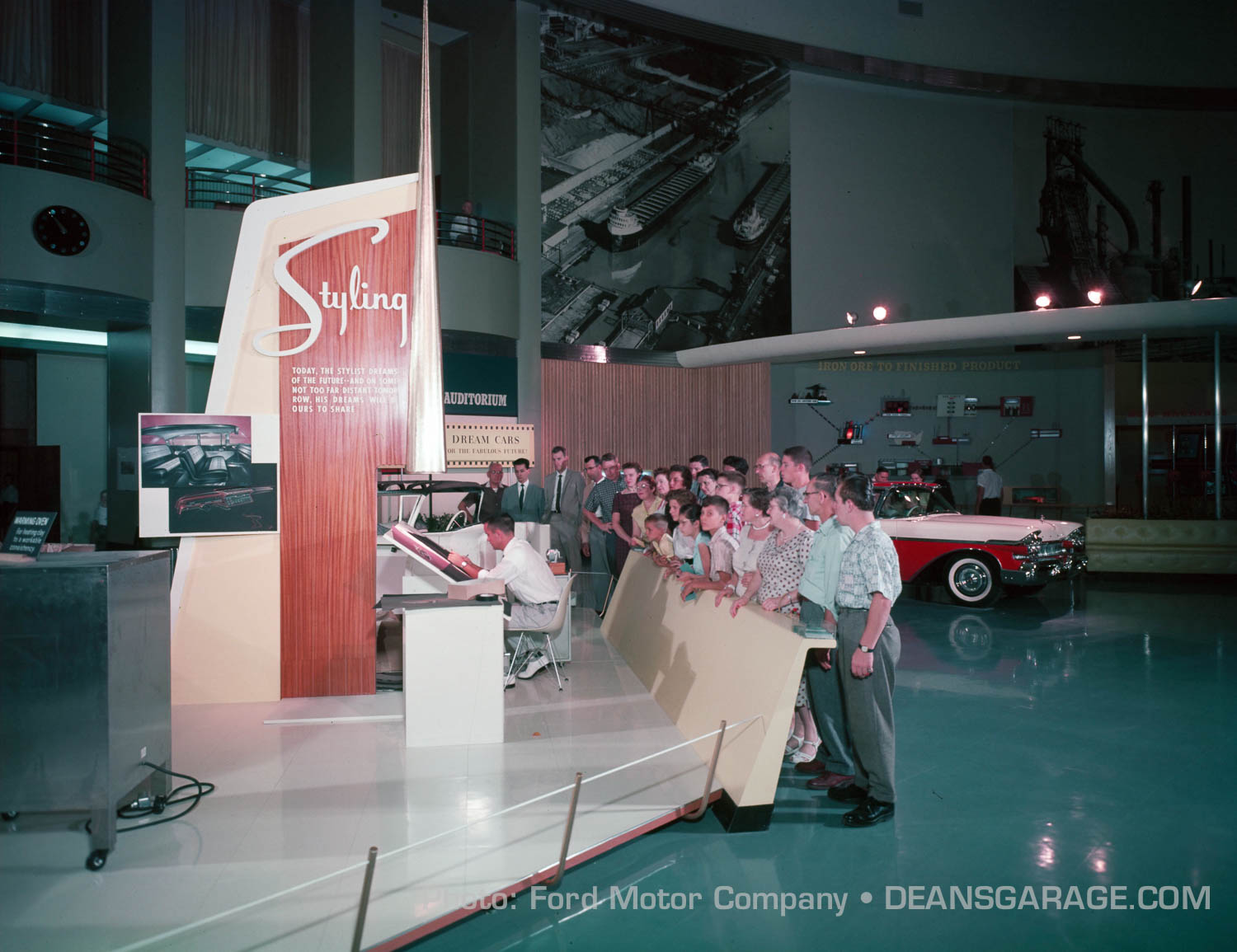
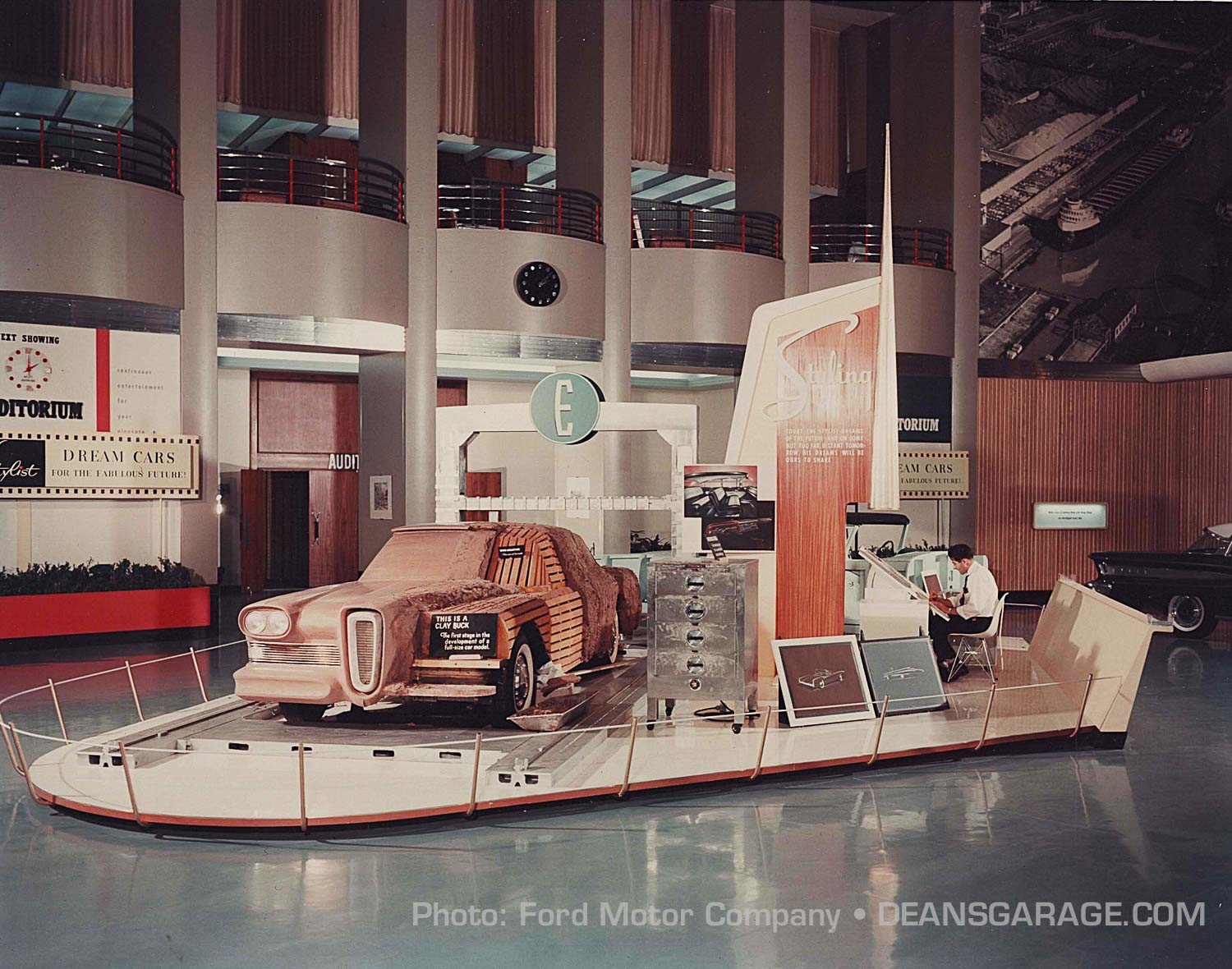
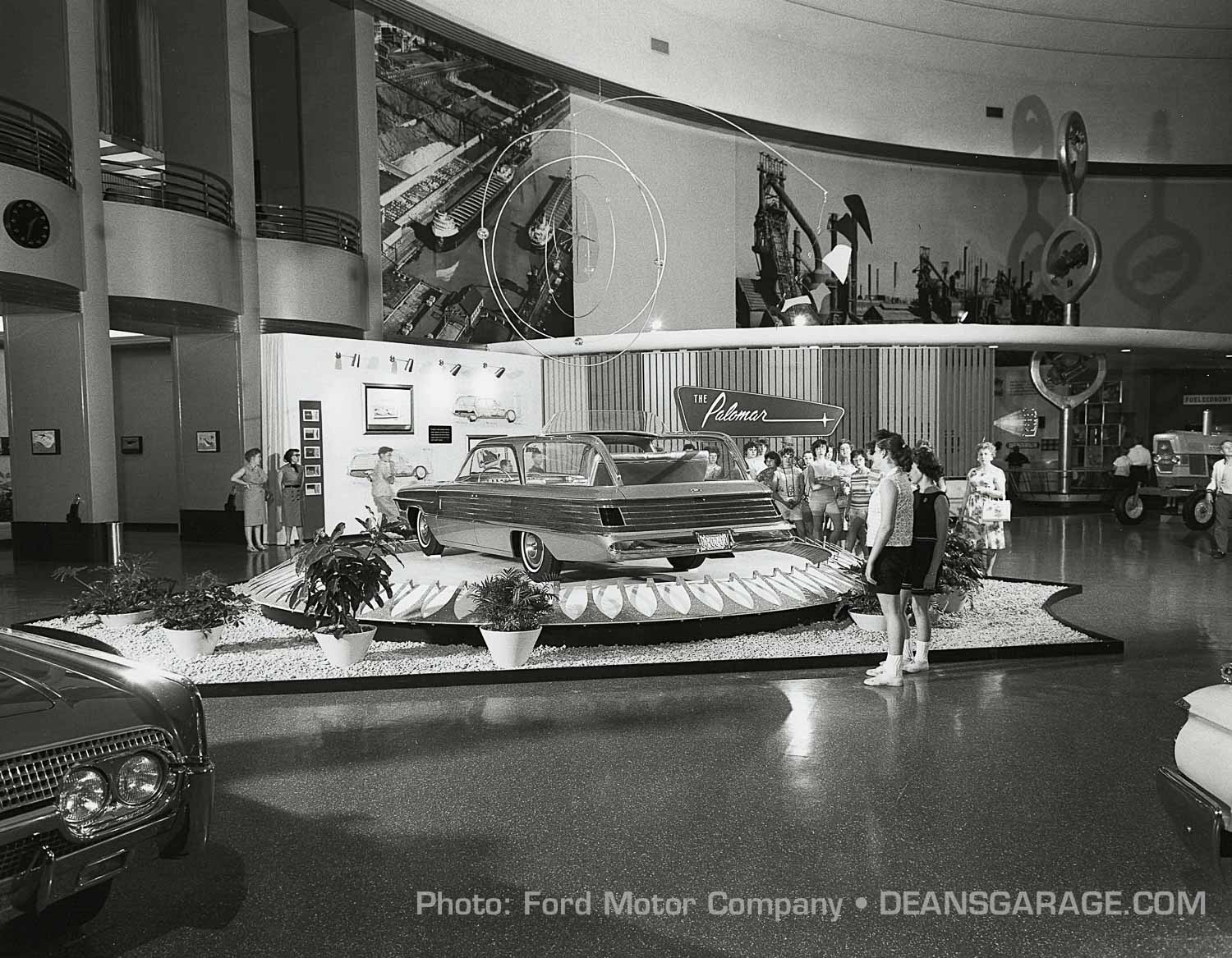
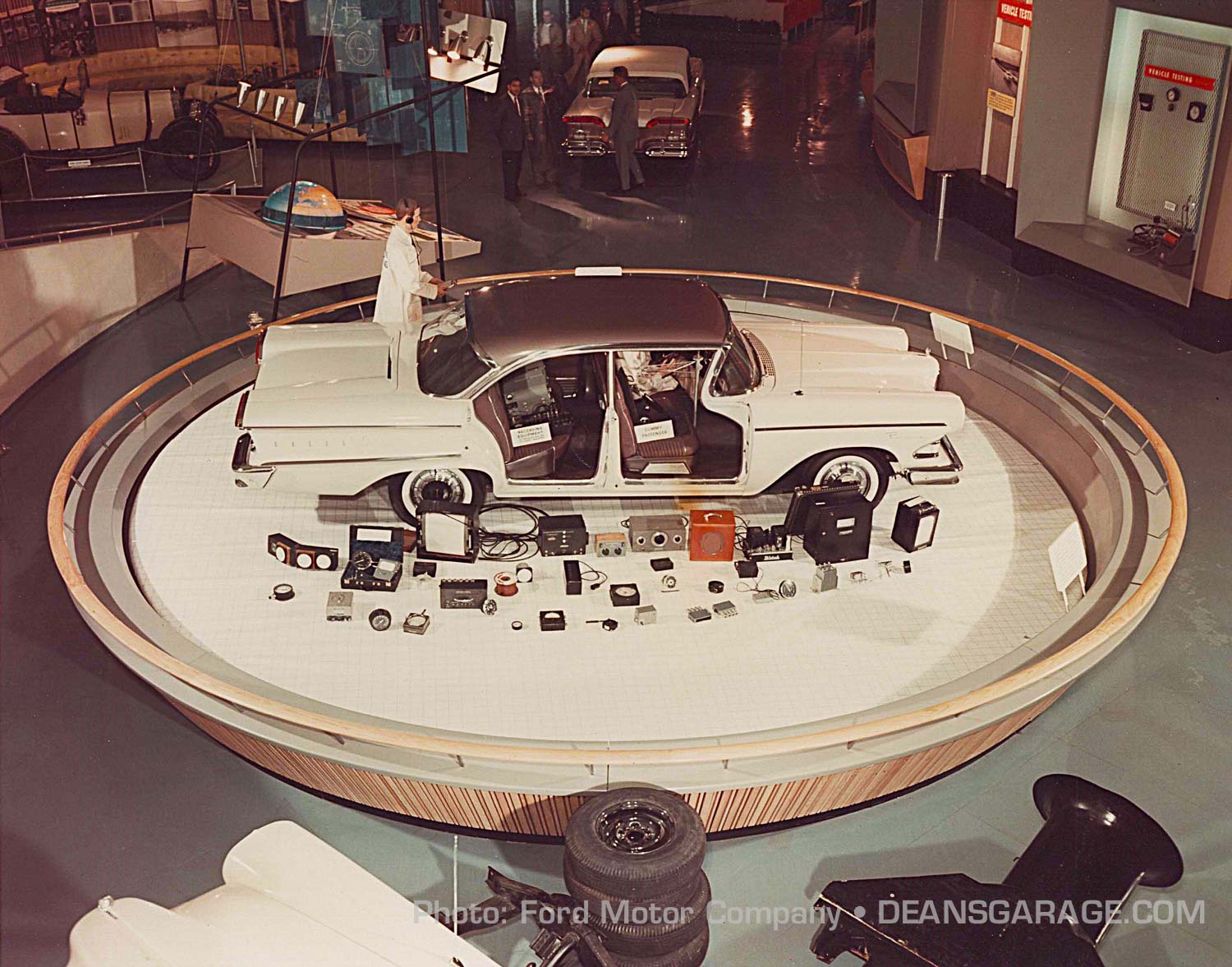
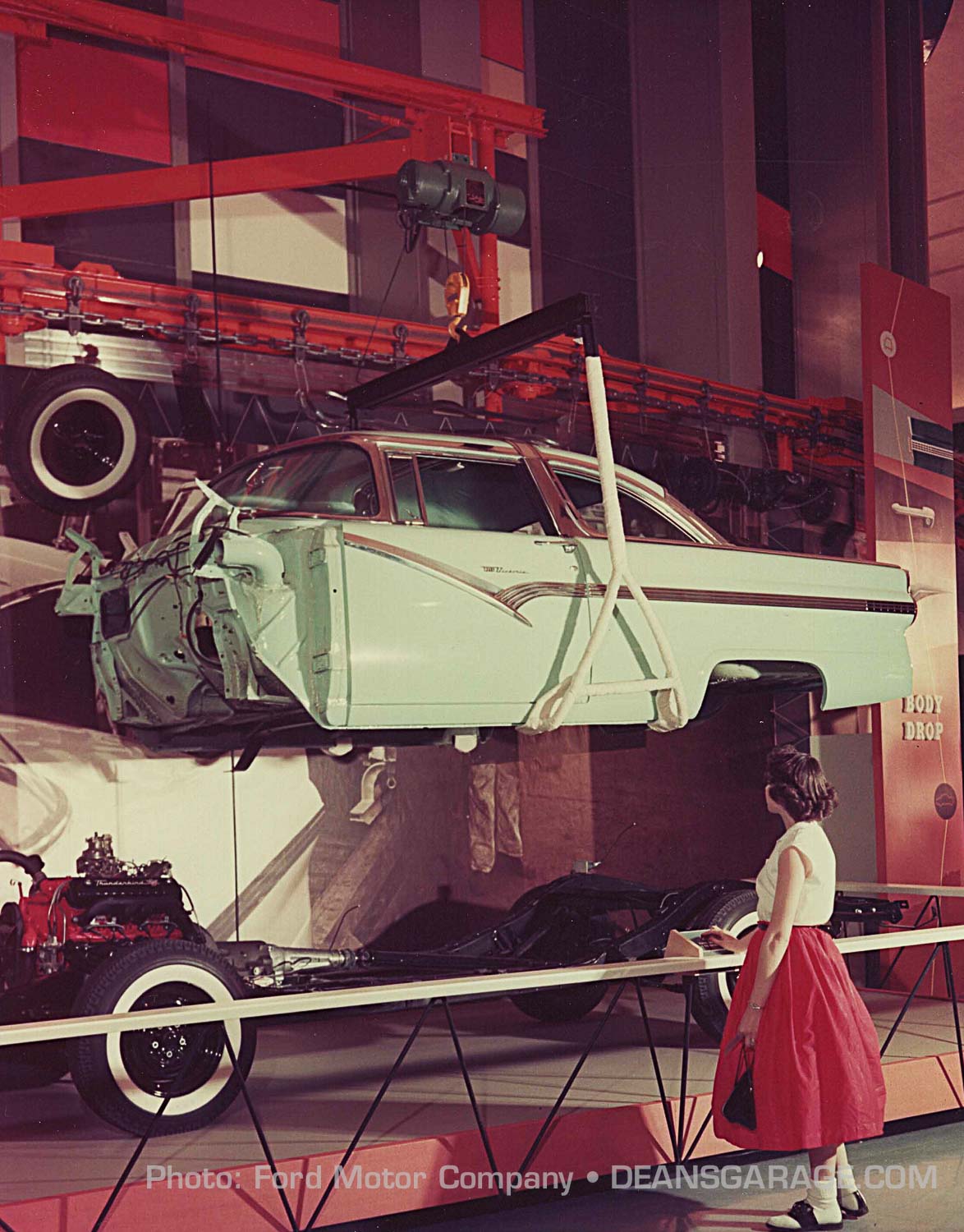
As mentioned before, styling and manufacturing operations were very popular displays at the Rotunda. Guests could actually watch a stylist at work at his desk. Displays such as the Edsel clay buck and numerous drawings highlighted the necessary steps in designing a car. Show cars were also on display such as the 1961 Palomar.
Note all the testing equipment surrounding this ’58 Edsel. Even that funny looking radiator snorkel was on display. It was also seen in my June 21, 2024 posting in Dean’s Garage attached to a ’57 Ford at Ford’s Michigan Proving Ground.
One of the very most popular displays was the simulated body drop. By pushing a few buttons a guest could lower into place this ’56 Crown Victoria’s Y-Block V-8 engine and then mate the body to the chassis. This was part of the “Making a Ford” display.
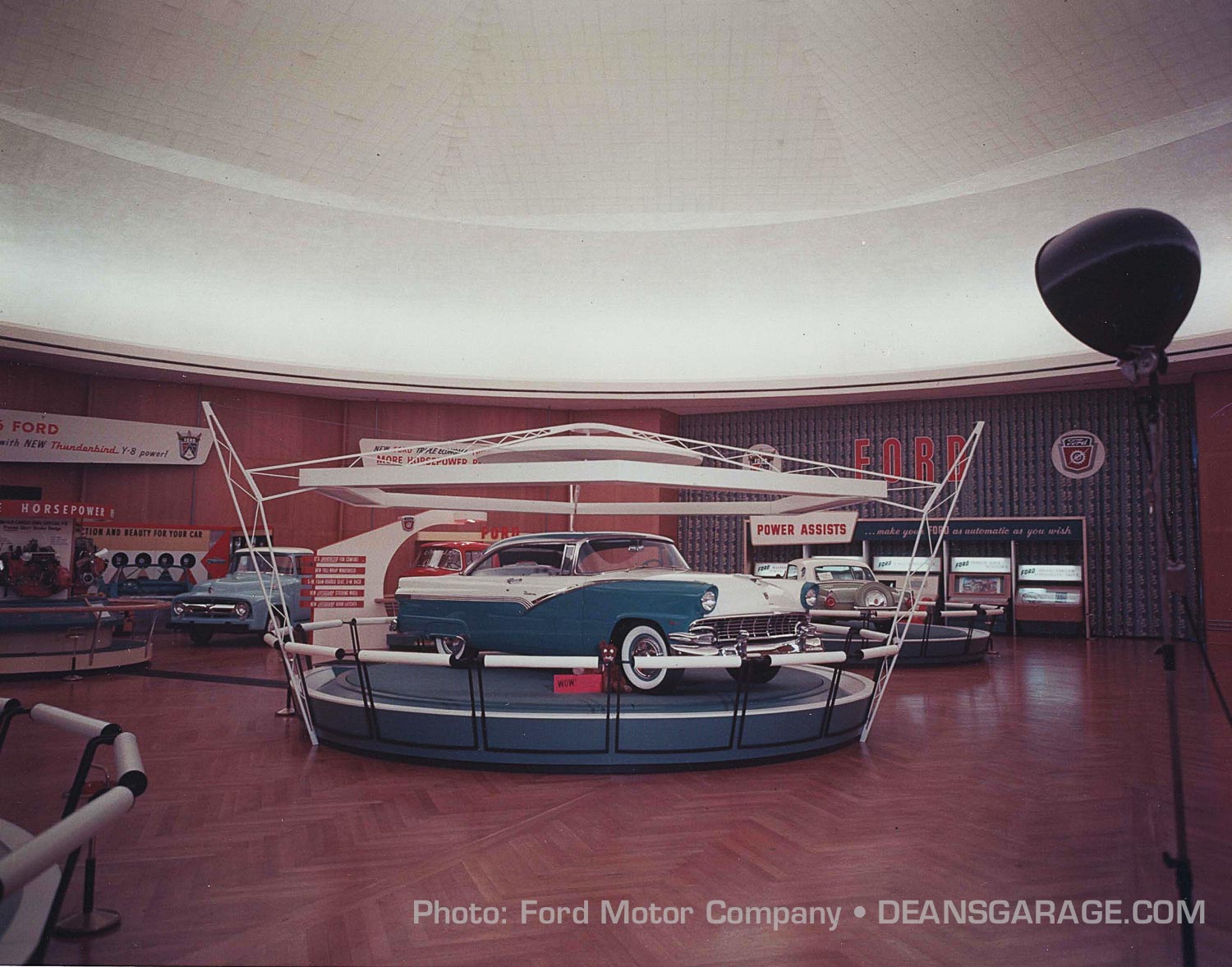
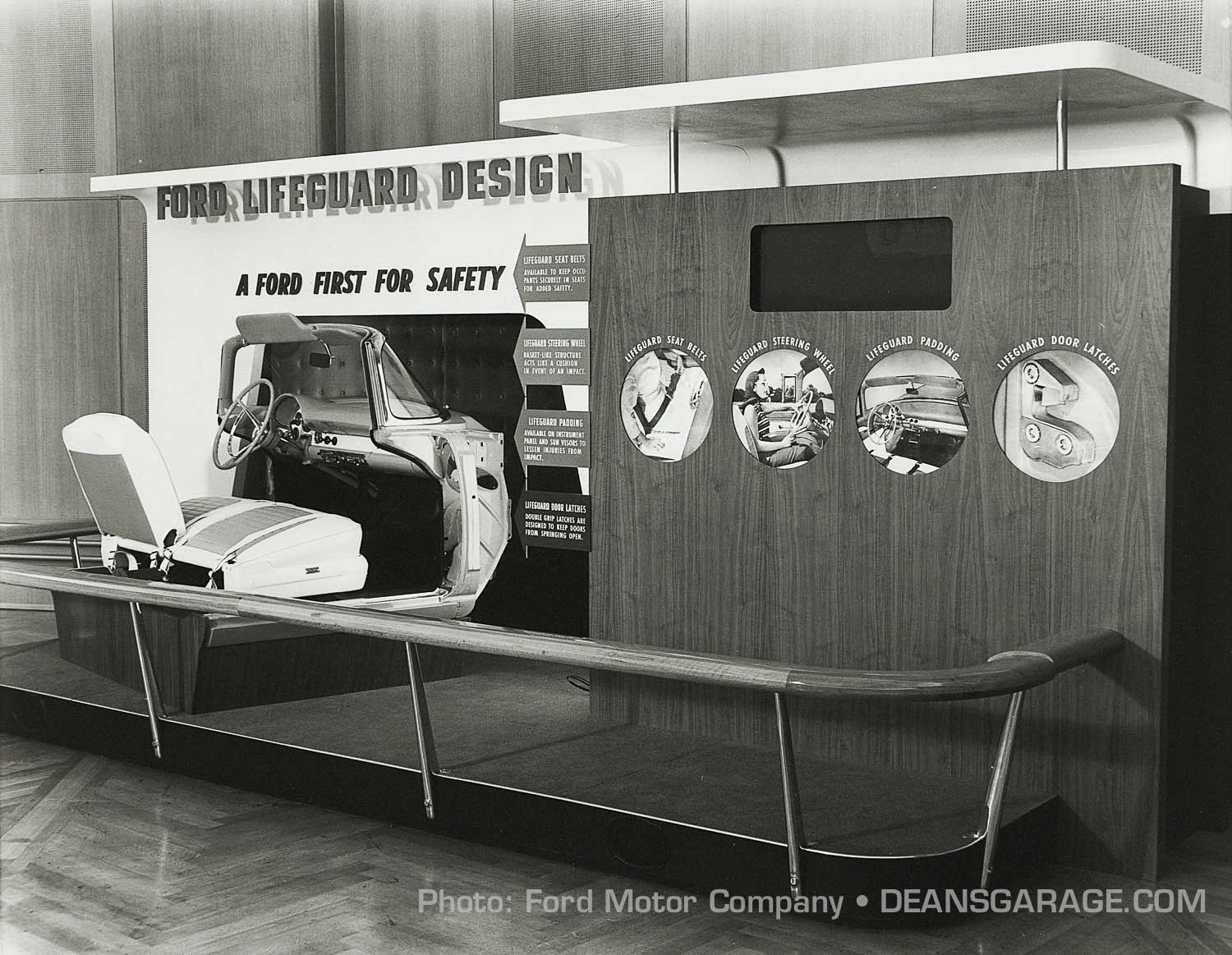
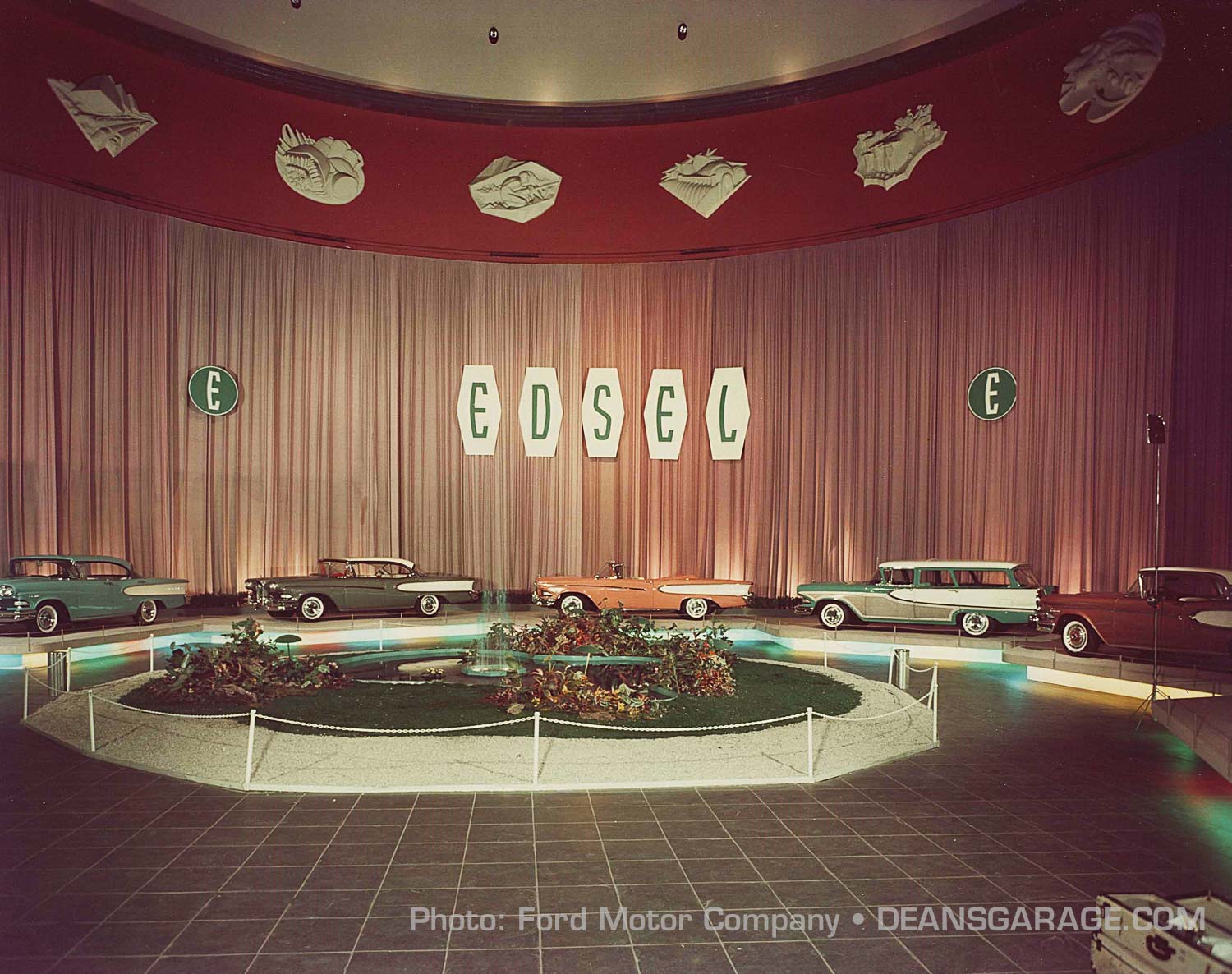
At times the Rotunda was also used for business functions such as press and dealer briefings. This 1958 Edsel stage was also used in promotional films.
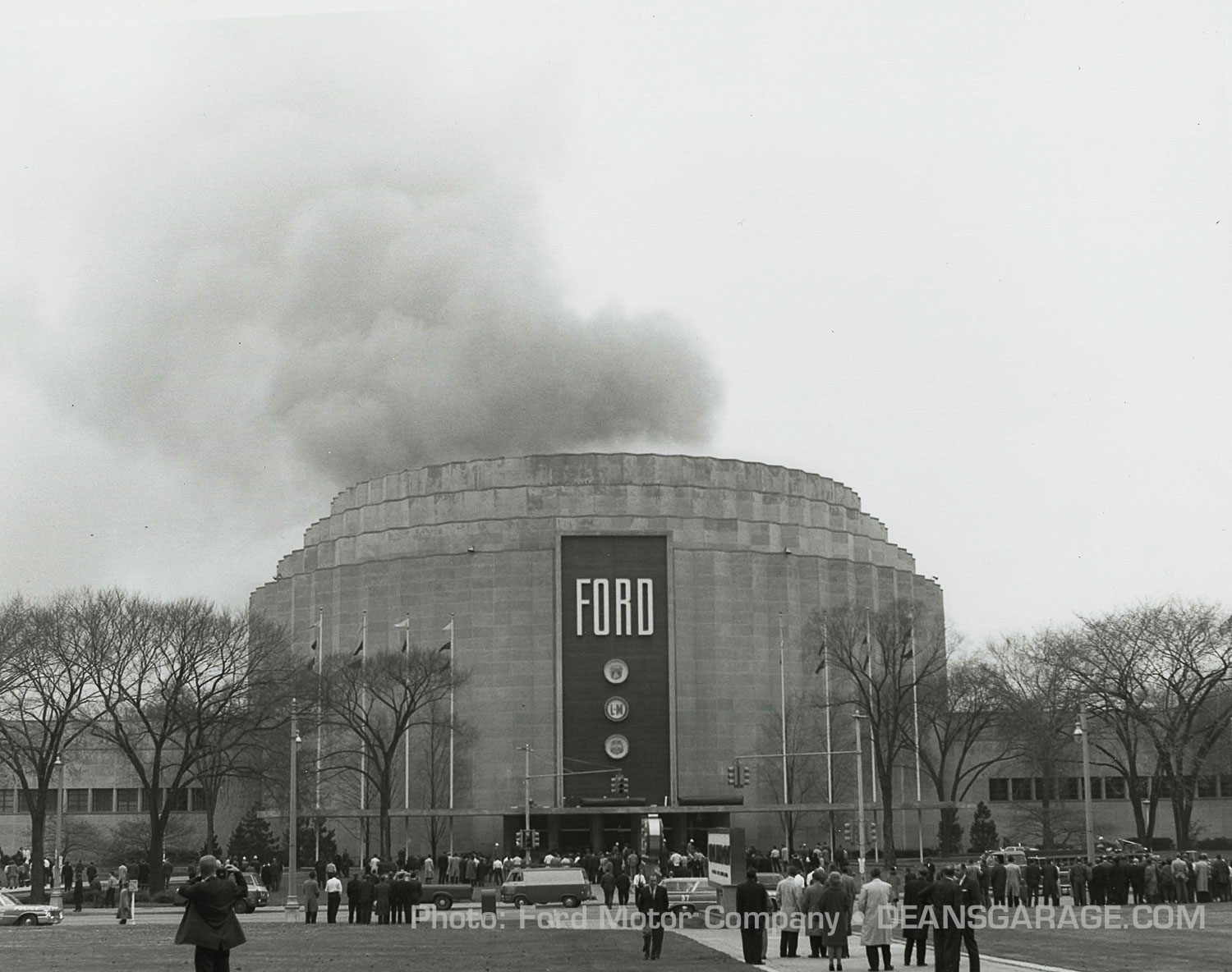
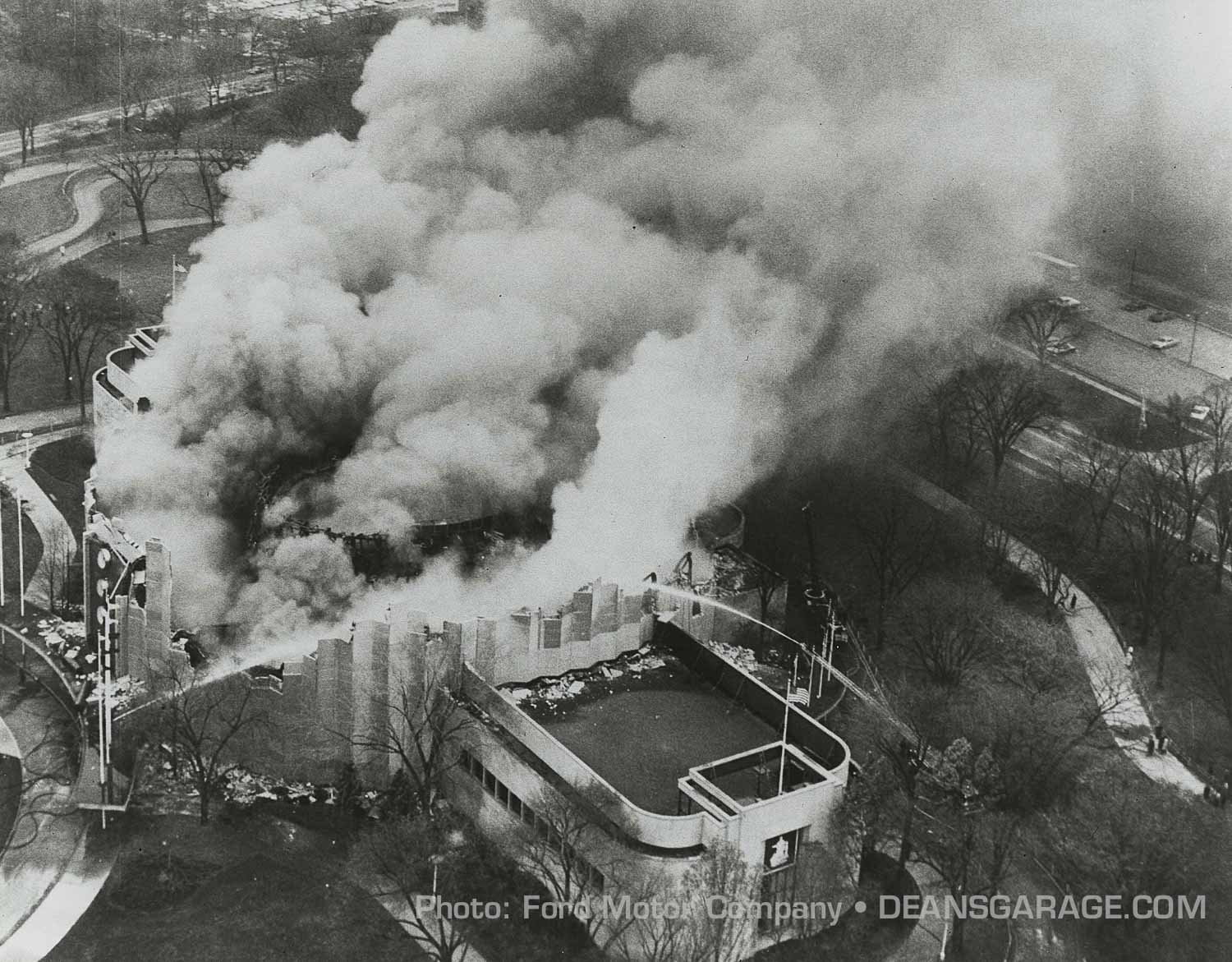
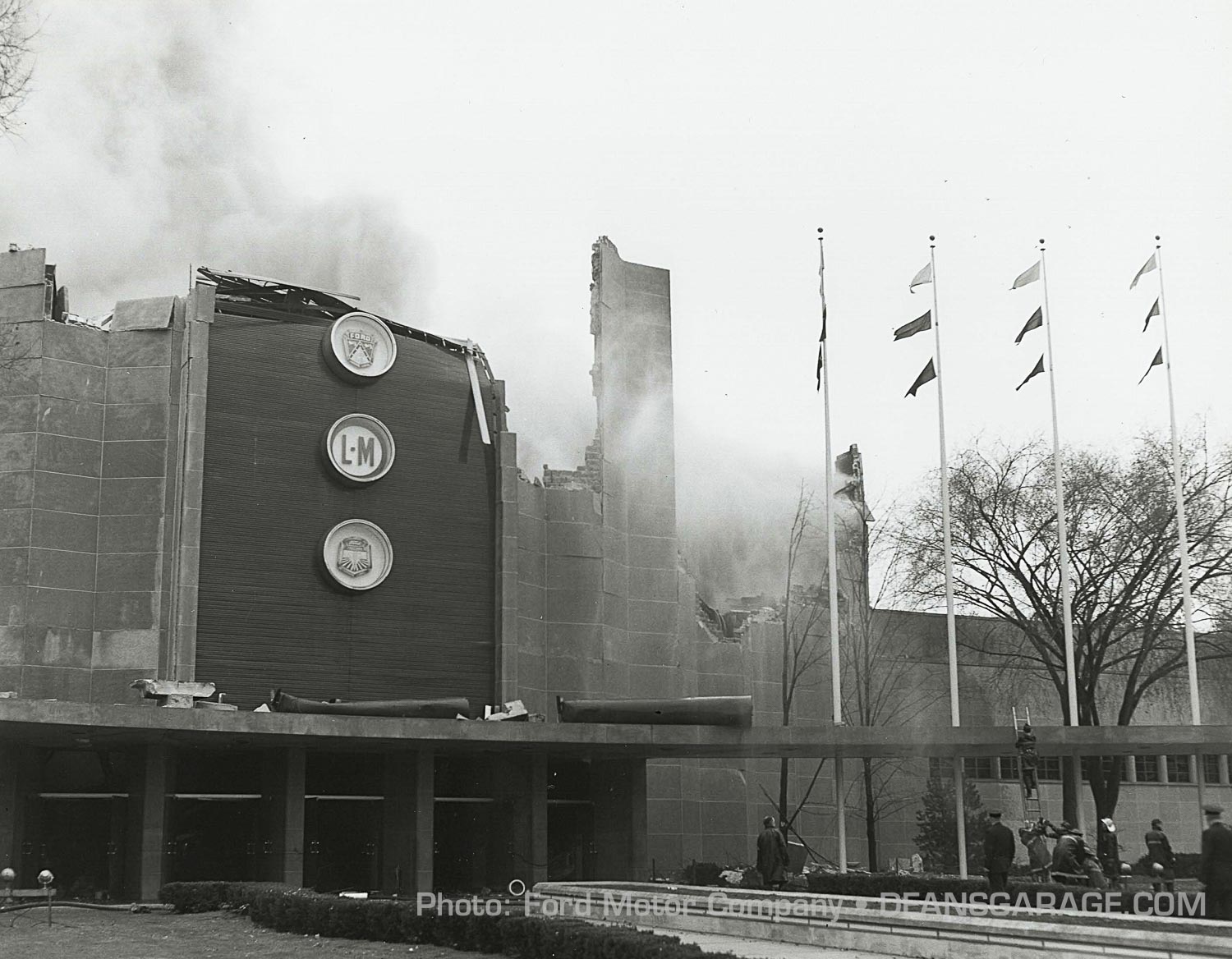
The end of this story is not a happy one. Early on November 9, 1962 contractors were on the roof repairing and resealing the Geodesic Dome. The tar like substance was heated on the ground by a propane fueled heater. It was then pumped to the roof and into a secondary barrel heated by an additional propane fueled heater to keep the substance liquefied. Hand signals between the worker on the ground and workers on the roof were miscommunicated. At around 1:00 p.m. the substance overflowed the barrel on the roof and vapors were ignited by the heater.
The workers on the roof attempted to put out the fire, but it apparently grew too quickly. They called the front desk who in turn evacuated the building and called the fire department. The clear panels of the Geodesic Dome, being plastic, burned quickly and that hot plastic fell upon the Christmas decorations being constructed below. By the time the fire department arrived at 1:20 p.m. heavy black columns of smoke were rising from the structure. It’s reported that the building collapsed at 1:55 p.m. Thankfully only one Ford engineer was injured while trying to turn on some roof water valves. The 70 remaining people in the building escaped uninjured.
The Rotunda was a total loss with one major exception. In 1957 Ford decided to move the company archives from the Henry Ford Fairlane Estate to the north wing of the Rotunda. Favorable north winds and instructions to the fire department saved them from destruction. Many of the images you see in this story and previous ones posted on Dean’s Garage were in that north wing during the fire. The loss of some nine million images, papers and documents would have been truly tragic.
Ford received countless calls and letters from the public wondering if and when the Rotunda was to be rebuilt. Sadly, it was not to be and in March of ’63 Ford announced that the remaining portion of the Rotunda would be demolished and not rebuilt. I wish Henry Ford II had made a different decision!
It’s been said that some million plus people a year visited the Rotunda from 1953 to 1962. It was fifth of the list of top ten attractions in the country through that time period and had an attendance greater than The Statue of Liberty, Yellowstone, Mount Vernon and The Washington Monument. Only Niagara Falls, The Great Smokie Mountains National Park, The Smithsonian, and The Lincoln Monument drew bigger crowds.
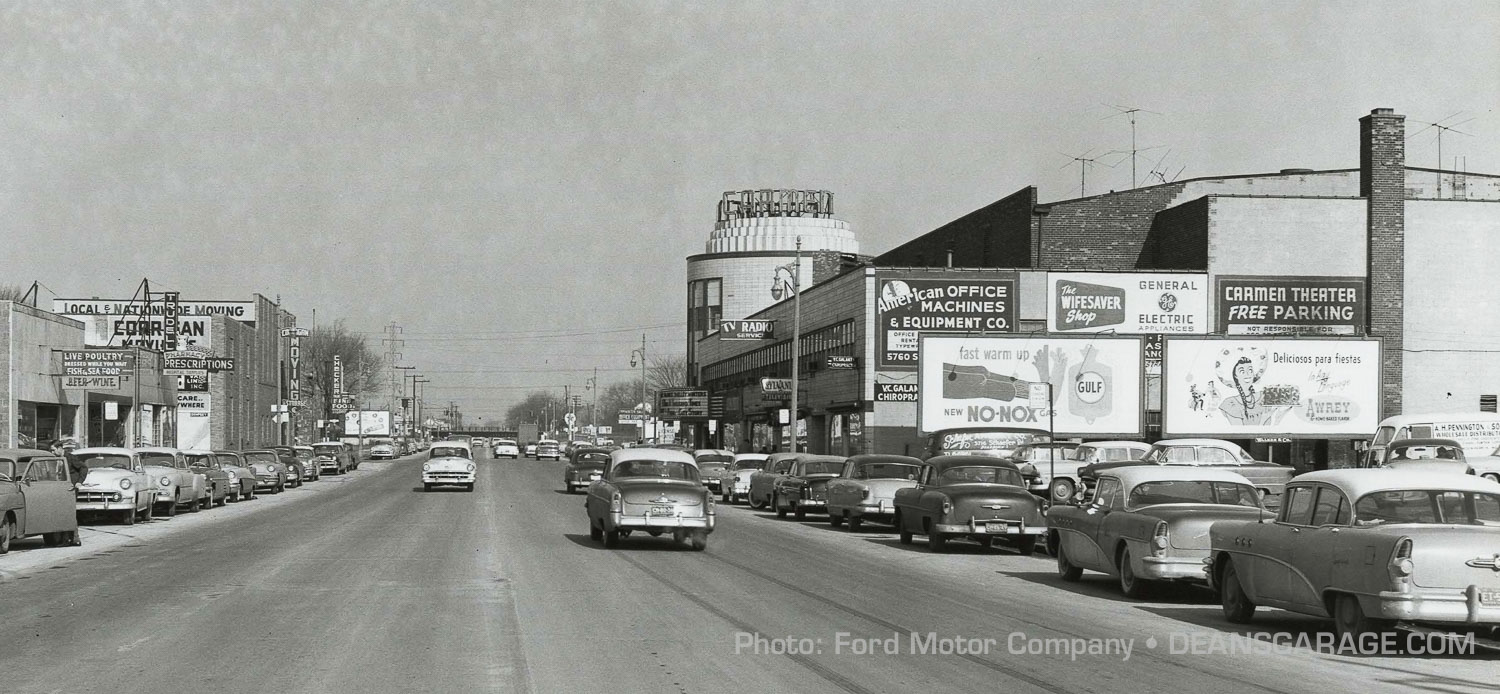
The Rotunda was so endeared that even Village Ford in Dearborn modeled their dealership showroom architecture after the Rotunda. (See comment by Chris from 11/18/24.)
The land sat empty till 2000 when the Michigan Technical Education Center was built on the site. The old Administration Building was also torn down and is now a storage lot for newly built F-150’s. Thankfully the name Rotunda Drive still exists.
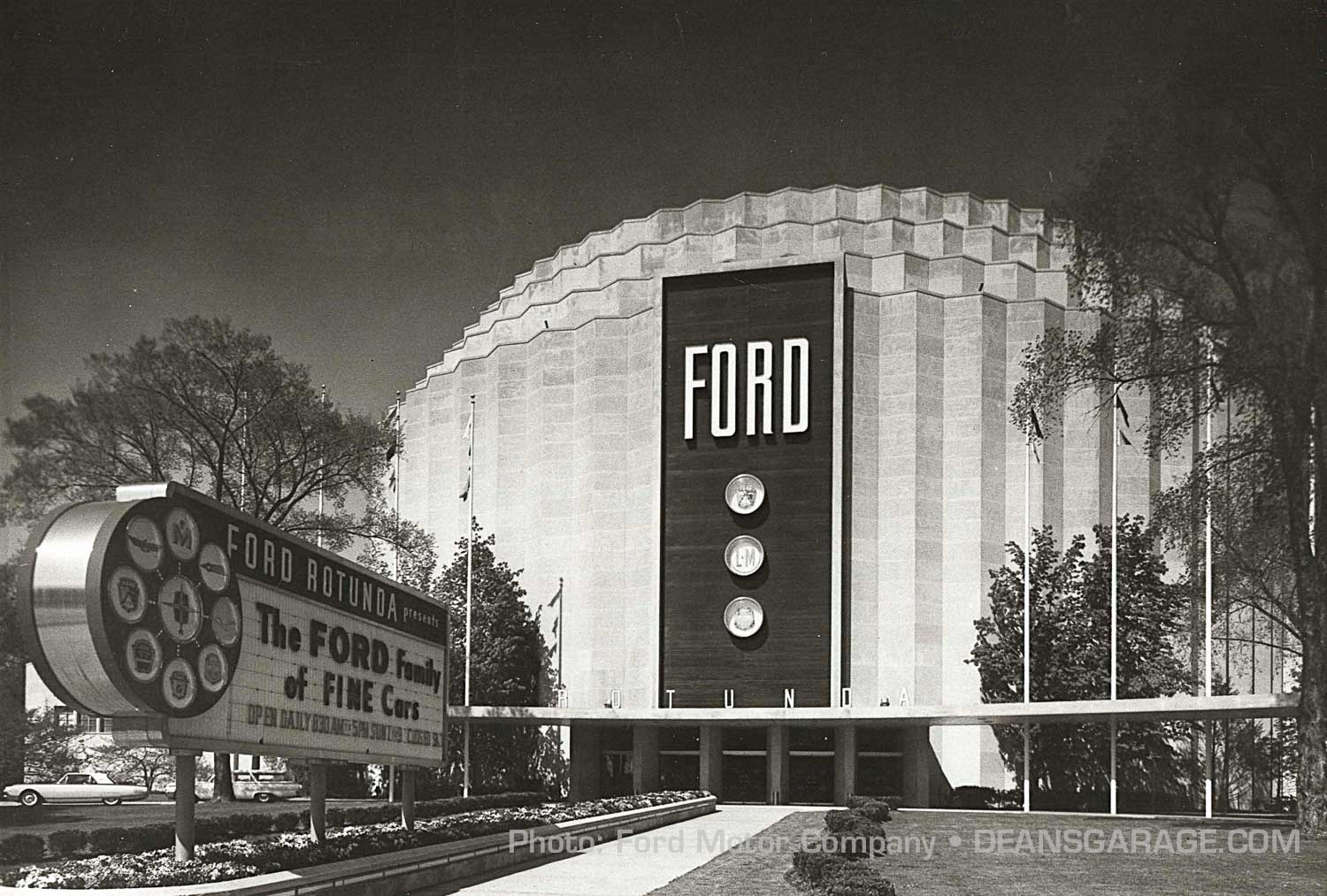
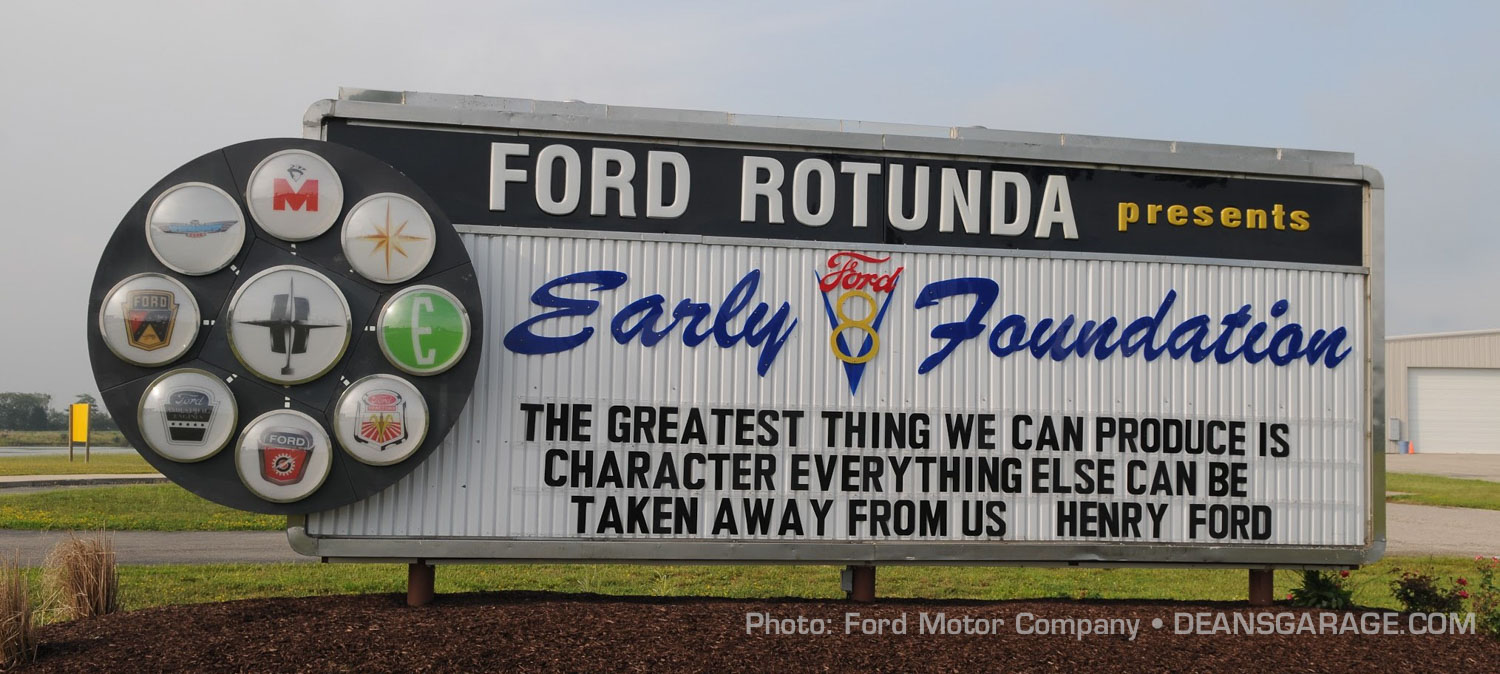
There is one remaining element from the Rotunda which can be seen today. The big sign out front. It currently resides in front of the Early Ford V-8 Foundation Museum in Auburn, Indiana. A wonderful museum worthy of a special trip!

Great piece!
Nothing says “1950s” like those typefaces and colors…
As a young child our family went to the Ford Rotunda to see the displays. It was there I discovered the profession of car designer with the Styling display. And that was started the ball rolling. https://driventowrite.com/2024/07/30/john-manoogian-career-recollections-part-one/
I use to fly my amphibious ultralight to Lakeville Lake and passed the Romeo proving grounds test track. There were a couple of covered car ports (about 1/4 mile long) that any car on the track would duck into when someone would see my airplane. I only took a couple of pictures. Nothing worth sharing. Good memories.
A very unique piece of American history, great write up and pictures.
A great piece of history, thank you for doing that story. I remember it, seeing it as a little kid. I think what is especially interesting is that in my opinion the car designs on display at that point in time we’re collectively some of the best that Ford ever did.
The Rotonda certainly would’ve had an influence on General Motors and developing the remote drama car program and the parade of progress.
Thank you again for the article, it was wonderful.
Glad I got to see it as a young boy. My father drove the family from the eastside to see the Christmas displays. Certainly one of my memories of the holiday season in the 1950’s.
Great story. What a tragic loss.
Many thanks Todd & Gary for a very interesting story with a sad ending. Put it into a book please…I will buy it.
Roy
My best friends parents took us there in 1957. We then toured the Rouge plant. After all that, I went home and drew 1957 Mercurys all summer! That was the start of becoming a designer for me.
I am both speechless and in tears… Nothing you have published has moved me so deeply. One of Henry II’s few ill-advised decisions was not to rebuild the Sistene Chapel of American ingenuity.
Did anyone catch the Mark II with the pre-production A-pillar configuration and dropped front-end?
The 1961 Palomar, named after California’s famed Caltech Observatory, comes dangerously close to station wagon designs Chrysler and Studebaker were contemplating at the time.
I agree, this should be memorialized in a large-format coffee table compendium. Hopefully, our more esteemed Ford authors out there with more direct access to these archives, will give such thought some erstwhile consideration!
Great topic and presentation. Remember it well and the free key chains handed out marking Ford’s 50th anniversary. I think the bean counters nixed the restoration.
Visited Rotunda summer ‘62. Ford should build another tourist magnet like it was. Oh, forgot—there’s no money.
Firstly, I sincerely appreciate all the kind comments. Glad the posting struck a chord for several of you.
For those wanting a book, I know of two. The History of the Ford Rotunda by Thomas Burke. It was published in 1977. Amazon has one should you be interested, albeit expensive. I have not seen a copy.
I do have a copy of Remembering The Ford Rotunda by Patricia Meyer and Amy Catallo. Only 44 pages but good story and photos. No date, but it looks like it was written more recently. I would think a copy could be obtained at The Henry Ford, Benson Ford Research Center or Detroit Historical Museum.
Reminds me that After the 1960s New York Worlds Fair I worked with Bill Mitchell to try to get GM to move the main exhibits to the vacant land east of the Tech Center. Three were many great exhibits including the ride of course.
Obviously we didn’t succeed.
Reminds me that there a great book about the Tech Center written by Susan Skarsgard called Where Today Meets Tomorrow. It includes all the early studies for the center. Not to be missed especially if you’re a GM guy like me. I worked there in the summer of 1956 when it was brand new and always drove around its various roads before leaving — just gorgeous!
Karl L.
I believe that Henry Ford II did not appreciate history in the same manner that his nephew, William Clay Ford, Jr., would embrace with the restoration of the Detroit Michigan Central railroad station. I wonder what became of the Indiana limestone used in the rebuilt Rotunda. I had no idea about the annual attendance of this site. H.F.II made a terrible mistake. Rebuilding was a drop in the bucket compared to the goodwill this building generated. What a great and ultimately sad story. Thank you.
Some years ago a friend took us to a yacht club on Gross Ile (I think) and showed us where the remains from the Rotunda had been dumped near the waters edge. It looked like a lot of dirty marble.
The Edsel disaster happened just a few years before the Rotunda burned. We can’t help but wonder if the fire had happened before the Edsel or after the Mustang came along would the decision have been different?
The memory of the Ford Rotunda lived on in the form of the name of the Ford Service Tools. Catalogs were published so that dealers could order the special tools needed to service each and every model of car and truck.
Tools and kits were prominently marked Rotunda.
Also ,for many years the screw on Ford engine oil filter had an end cap in the shape of the
Rotunda Bldg. roof.
My uncle took me there summer of 1952. I knew I wanted to be a car designer by then-age11- and felt the excitement of my future home. We did the full tour , saw the new 1953 Fords coming off the line. It was fantastic. Thanks for this memory!
Seems like a perfect topic for Henry Dominguez to write about in a similar fashion to his wonderful “George Walker: Cellini of Chrome” with its wealth of color photographs and great narrative. His other books on Ford history, “Edsel Ford and E.T. Gregorie: The Remarkable Design Team and Their Classic Fords Of the 1930s and 1940s”, “Edsel: The Story of Henry Ford’s Forgotten Son” and “The Last Days of Henry Ford” are well worth a read for anyone interested in Ford Motor company history. Dominguez is a popular historian of the company with these releases to date.
I appreciate this write up. I have one thing to point out though. The last photo with the caption talking about Village Ford is actually the Carmen Theatre, which was located on Schaefer and Warren.
As per Karl Ludvigsen’s comment, Susan Skarsgard’s book on the GM Tech Center “Where Today Meets Tomorrow” is a wonderful history of the Eero Sarrinen-designed complex with many illustrations. I could picture the venue well while reading “Chevrolet: Racing? Thirteen Years of Raucous Silence” by Paul Van Valkenburgh, written in 1972 and re-published years later, recounting the GM Tech Center Chevrolet R&D Department’s intense involvement in supporting competition motor sport in the late 1950s to the late 1960s. (I also have a book on my favorite GM product the era, the Corvair, (a ’65 Monza 140 4-speed coupe was my first car) with a pic of Karl looking on the open cockpit and rear engine covers of GM’s great Corvair Monza GT, an example of their period industry-leading advanced experimental cars with its monocoque tub and mid-engine design.)
Addendum: Not only was the 1962 Corvair Monza GT advanced engineering, it displayed GM design talent. It was penned by Larry Shinoda (who followed Bunkie Knudson to Ford in the late 1960s and styled the Boss 302) and incorporated many design and engineering elements that appeared in later vehicles, like the design of the rear cove of the 2nd gen 1965-1969 Corvair, and in competition machines like the front end style of early Chapparals and the monocoque-mid-engine-design of Jim Hall’s machines. Hall’s engineering genius advanced the science by employing lighter-weight and stiffer fiberglass tubs instead of aluminum as used in the Monza GT. In the 1960s, GM was in the vanguard of engineering and design and Chevrolet R&D had a synergistic relationship with motorsport figures like Hall, McLaren and Penske.